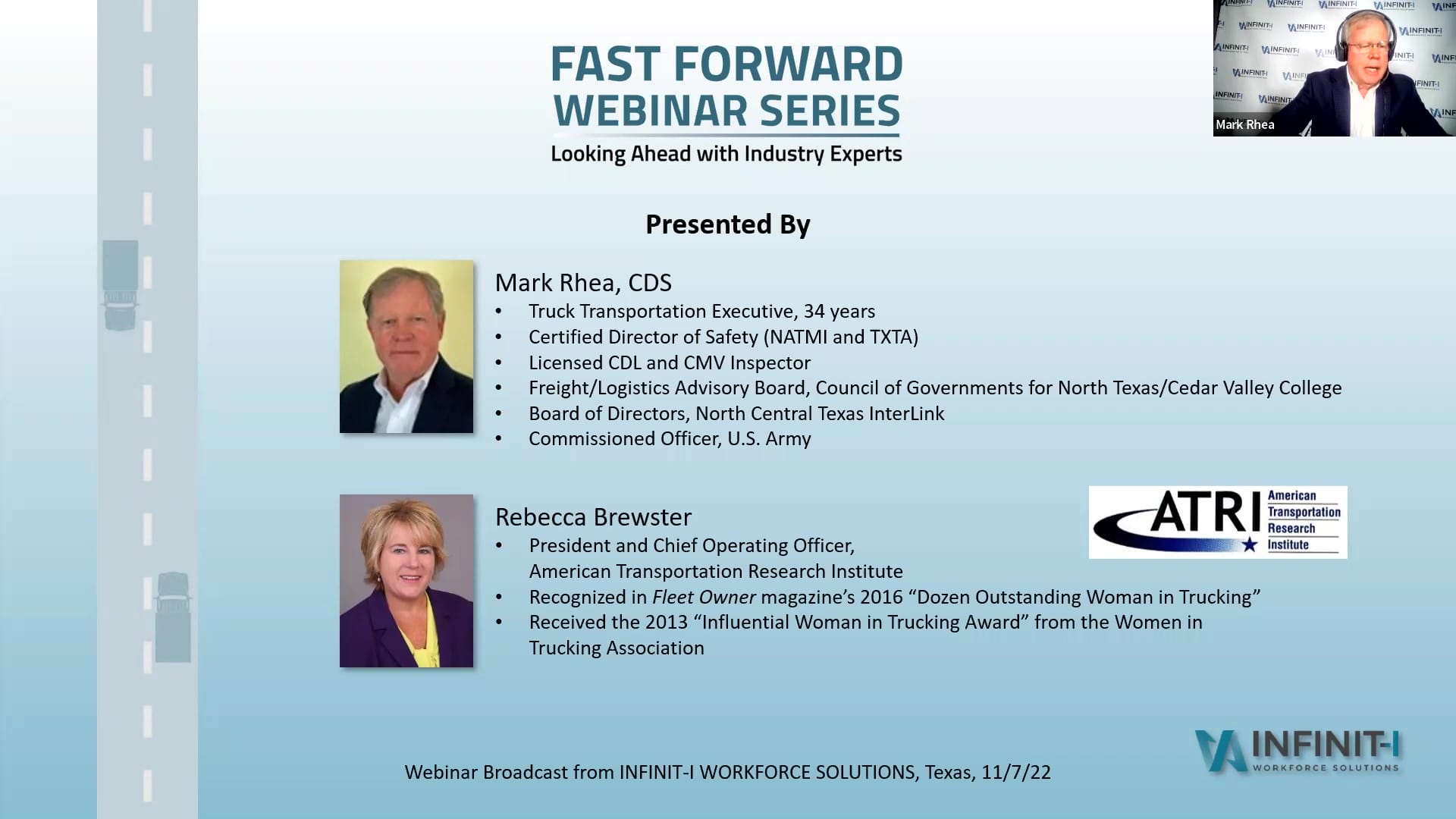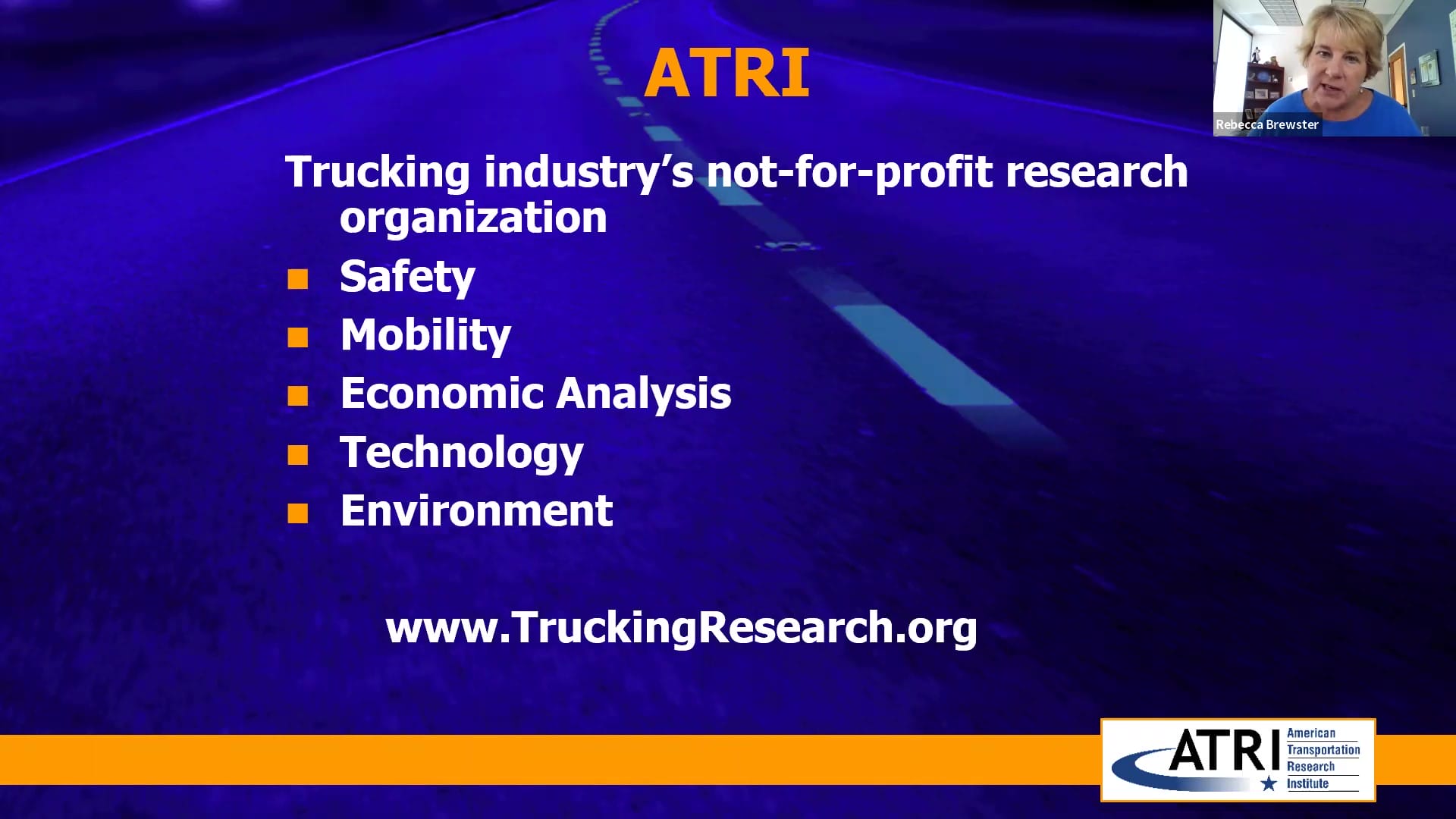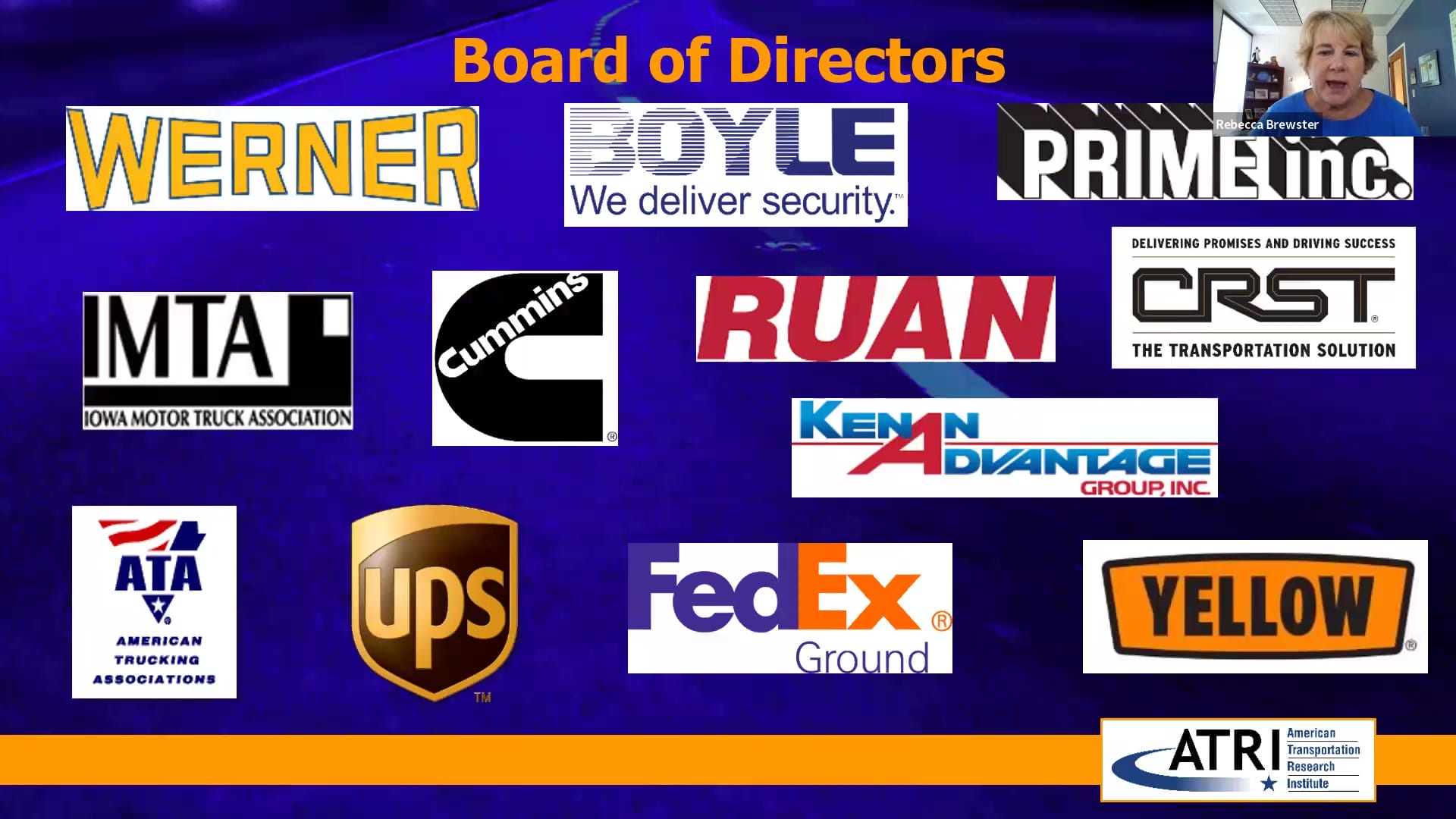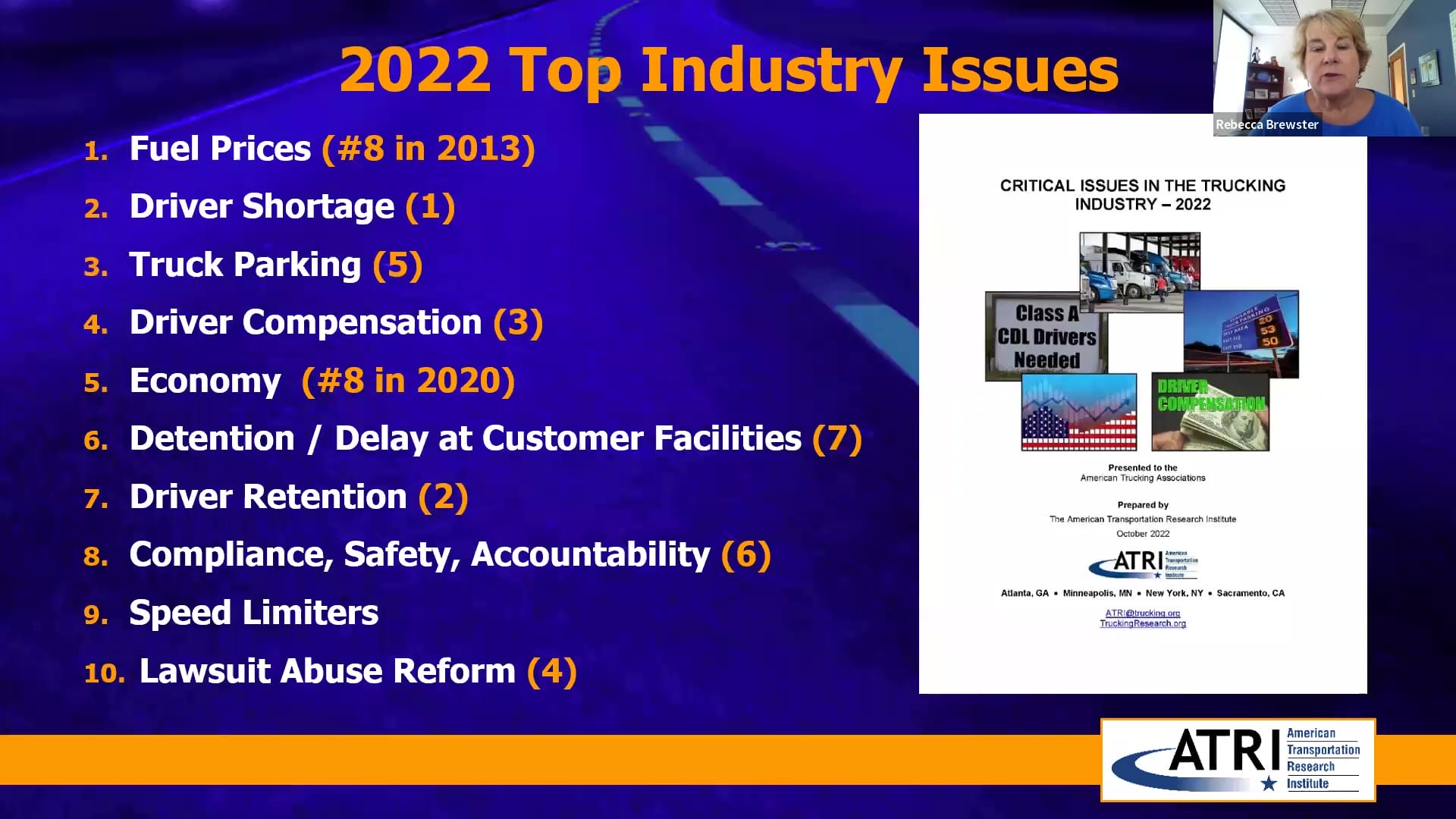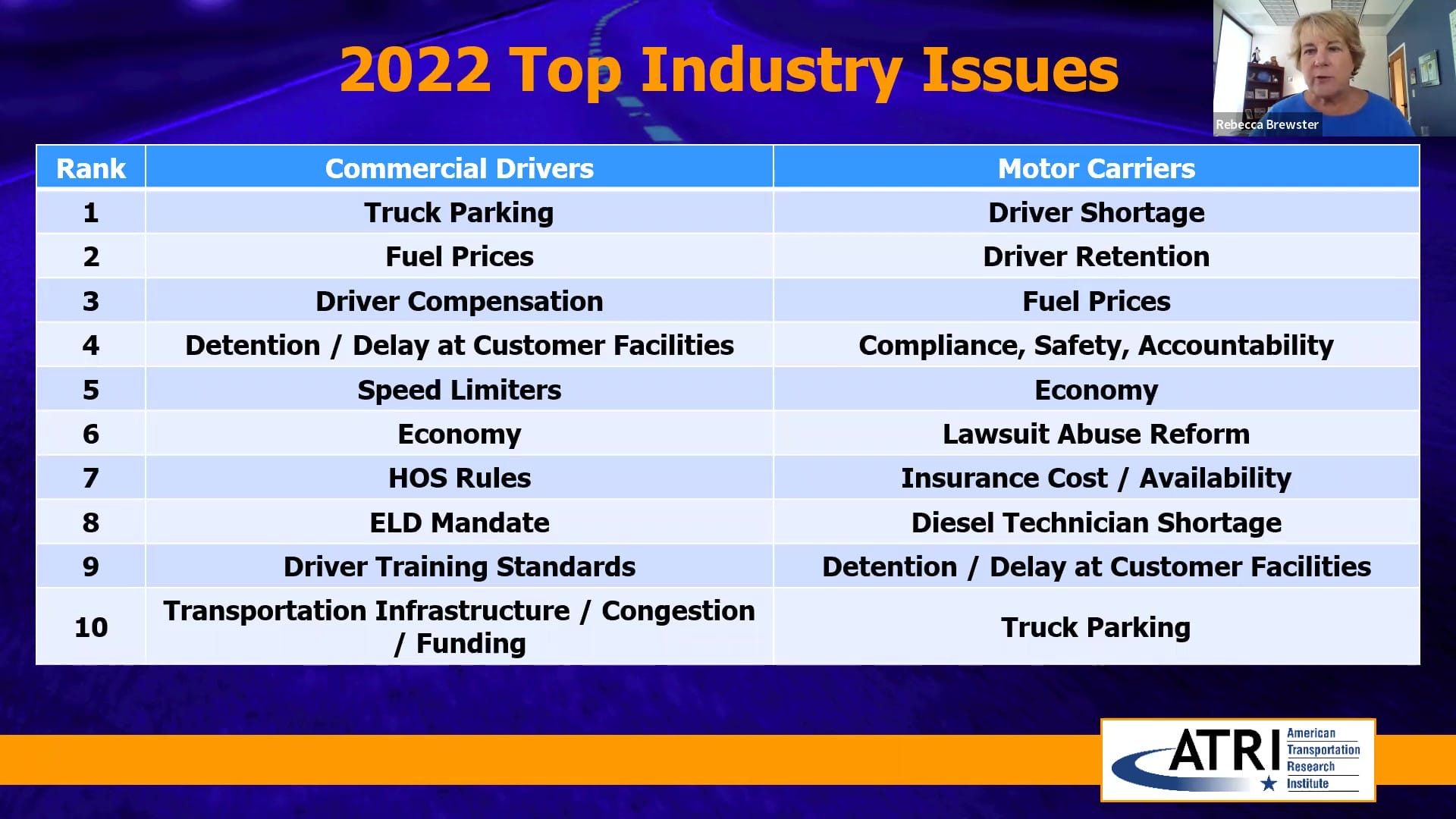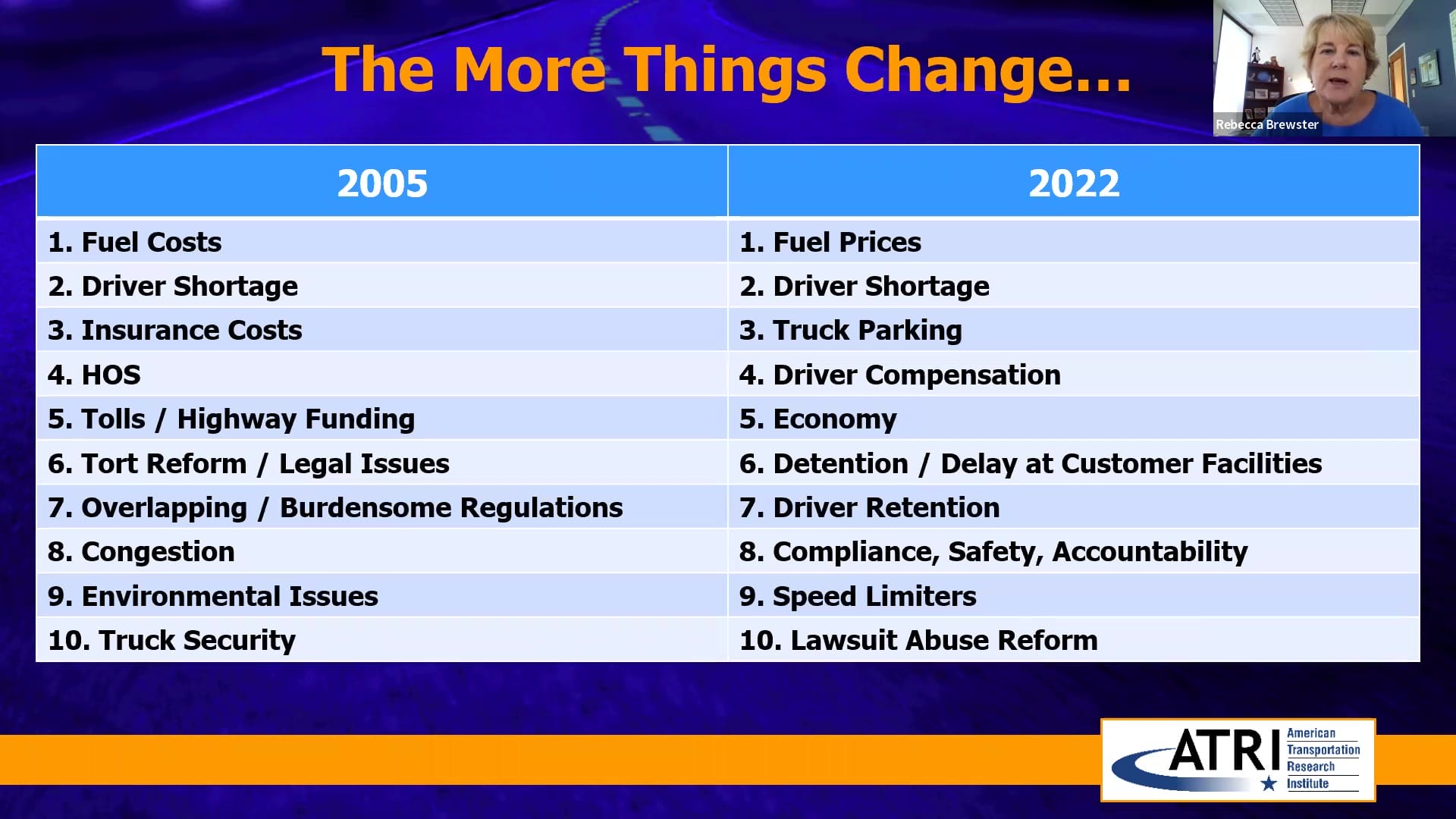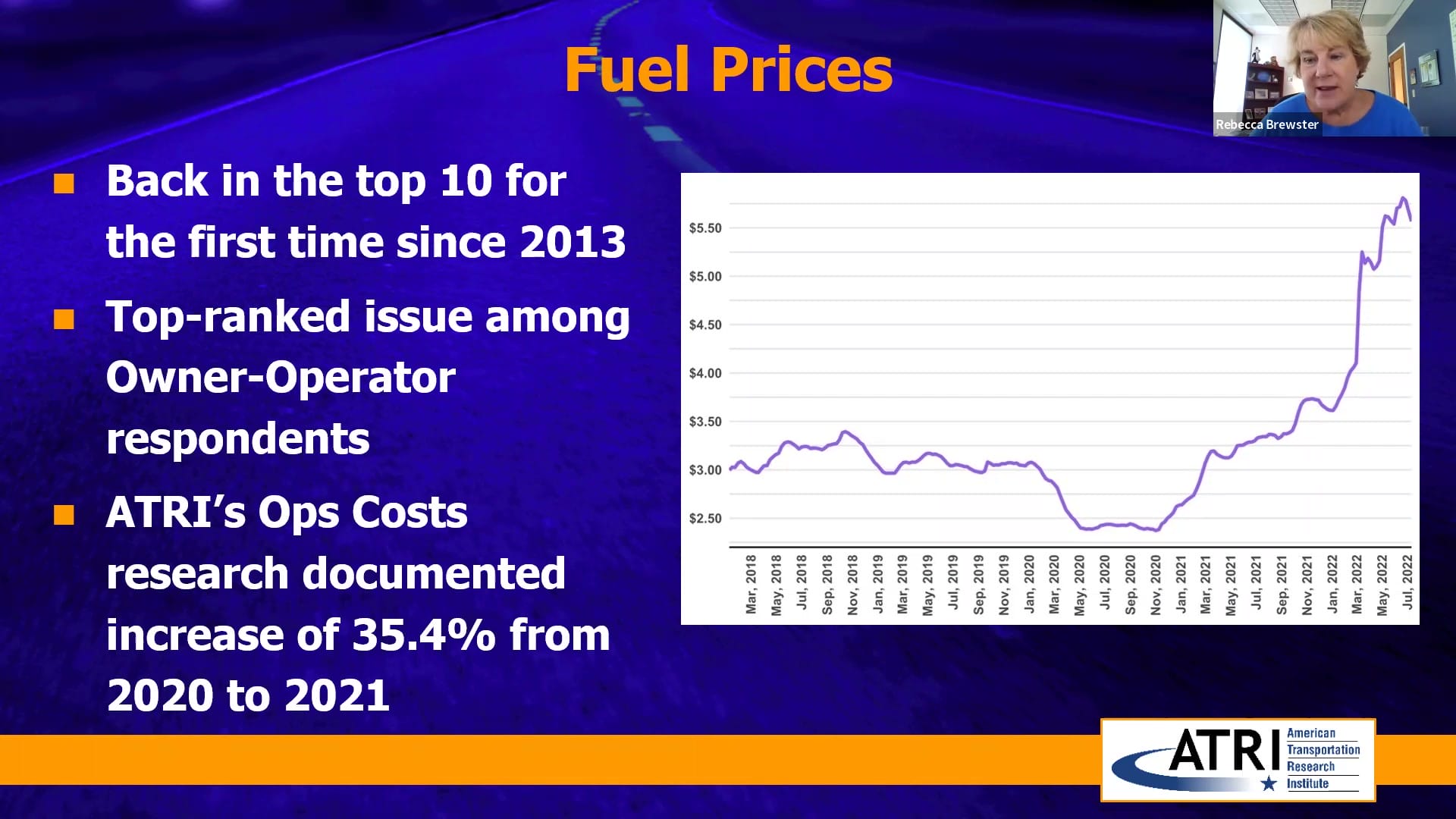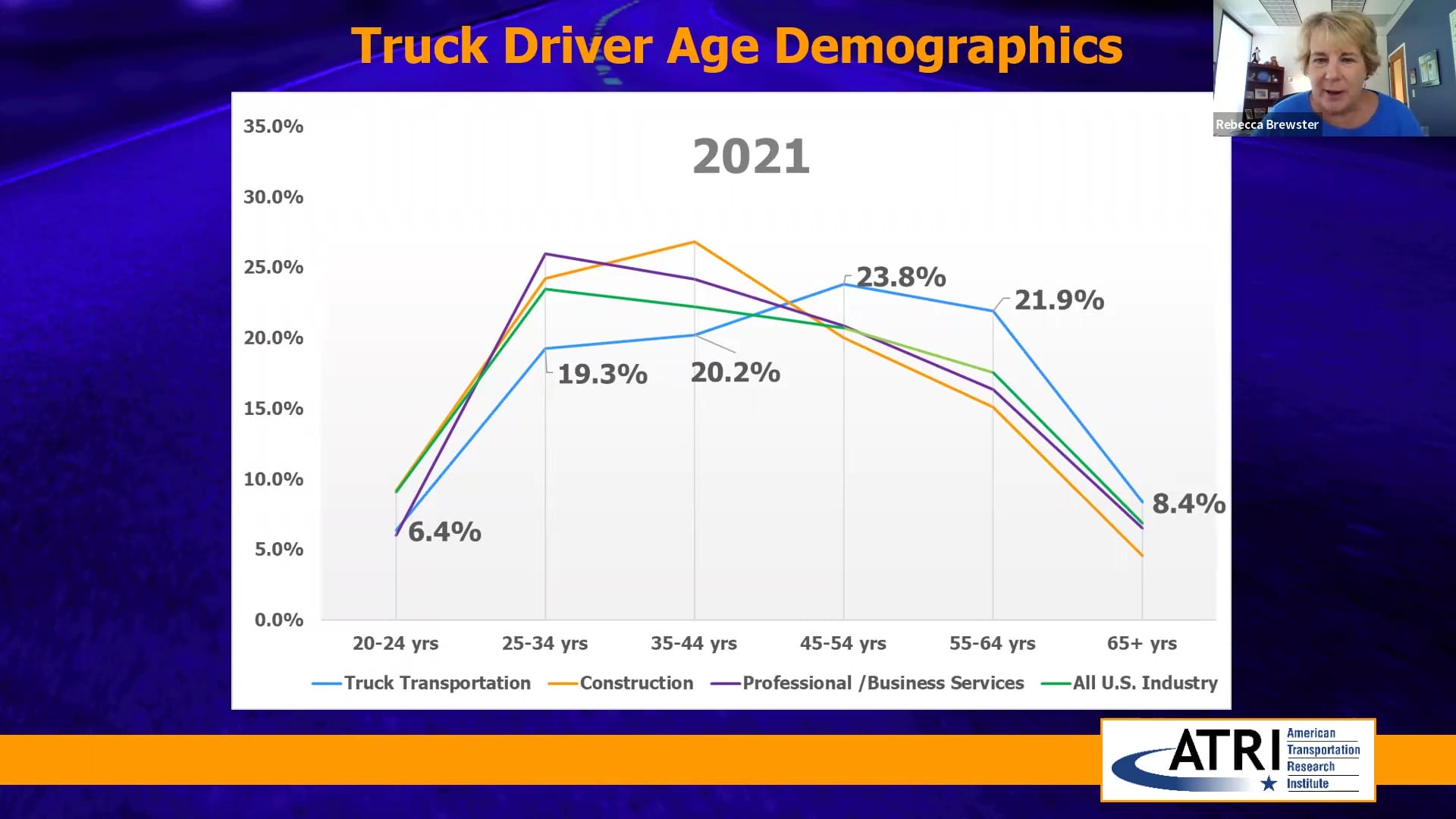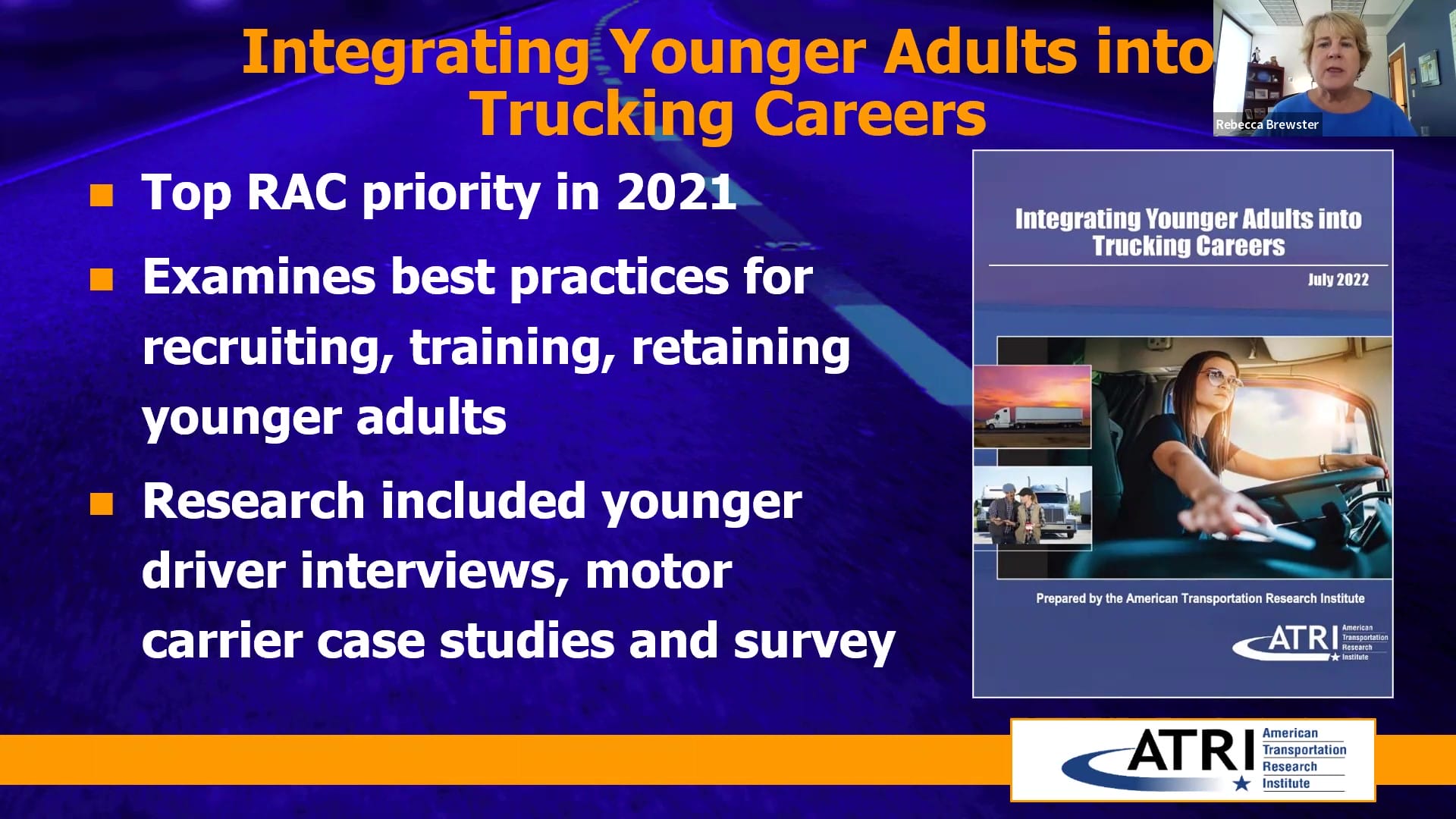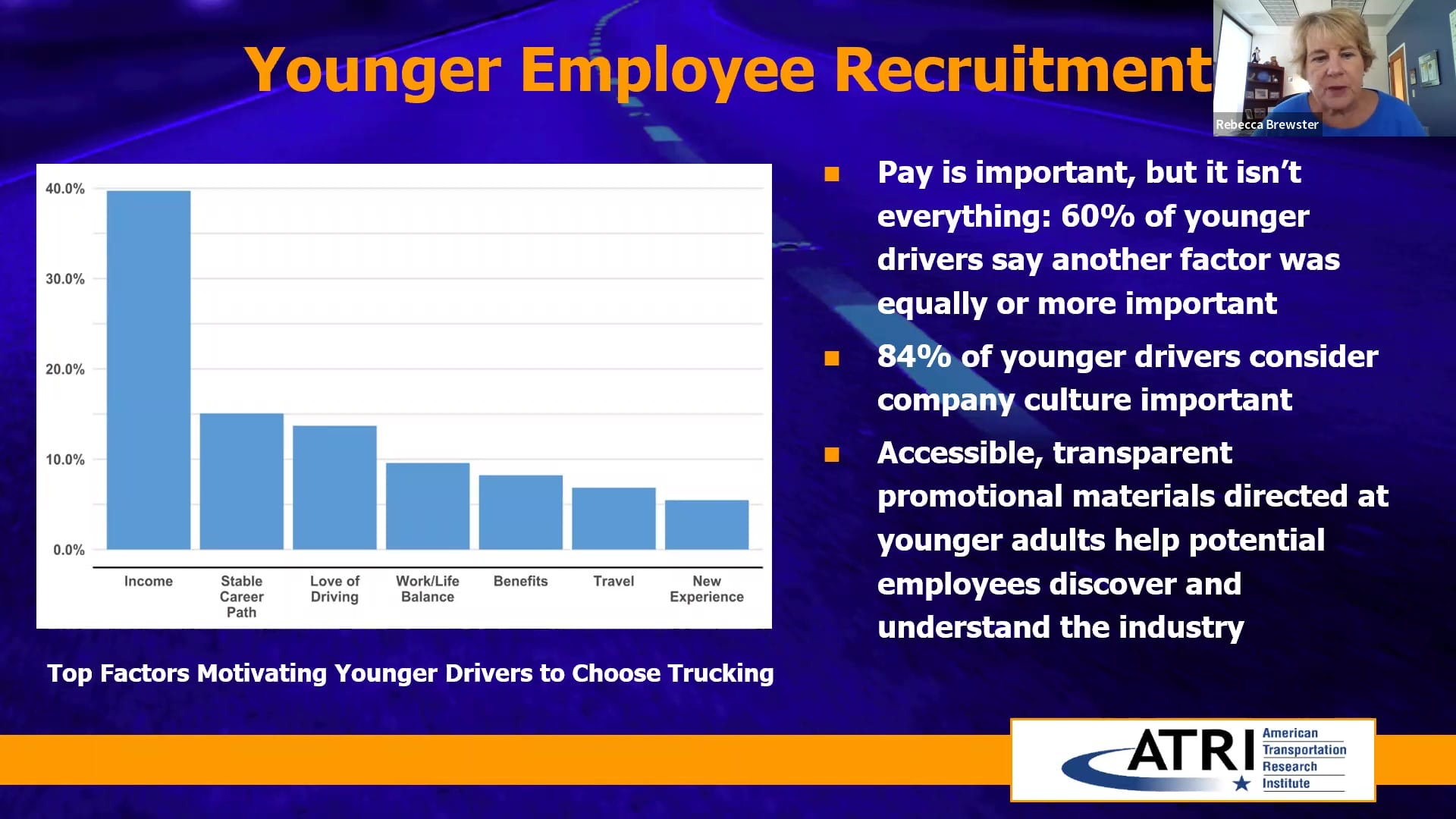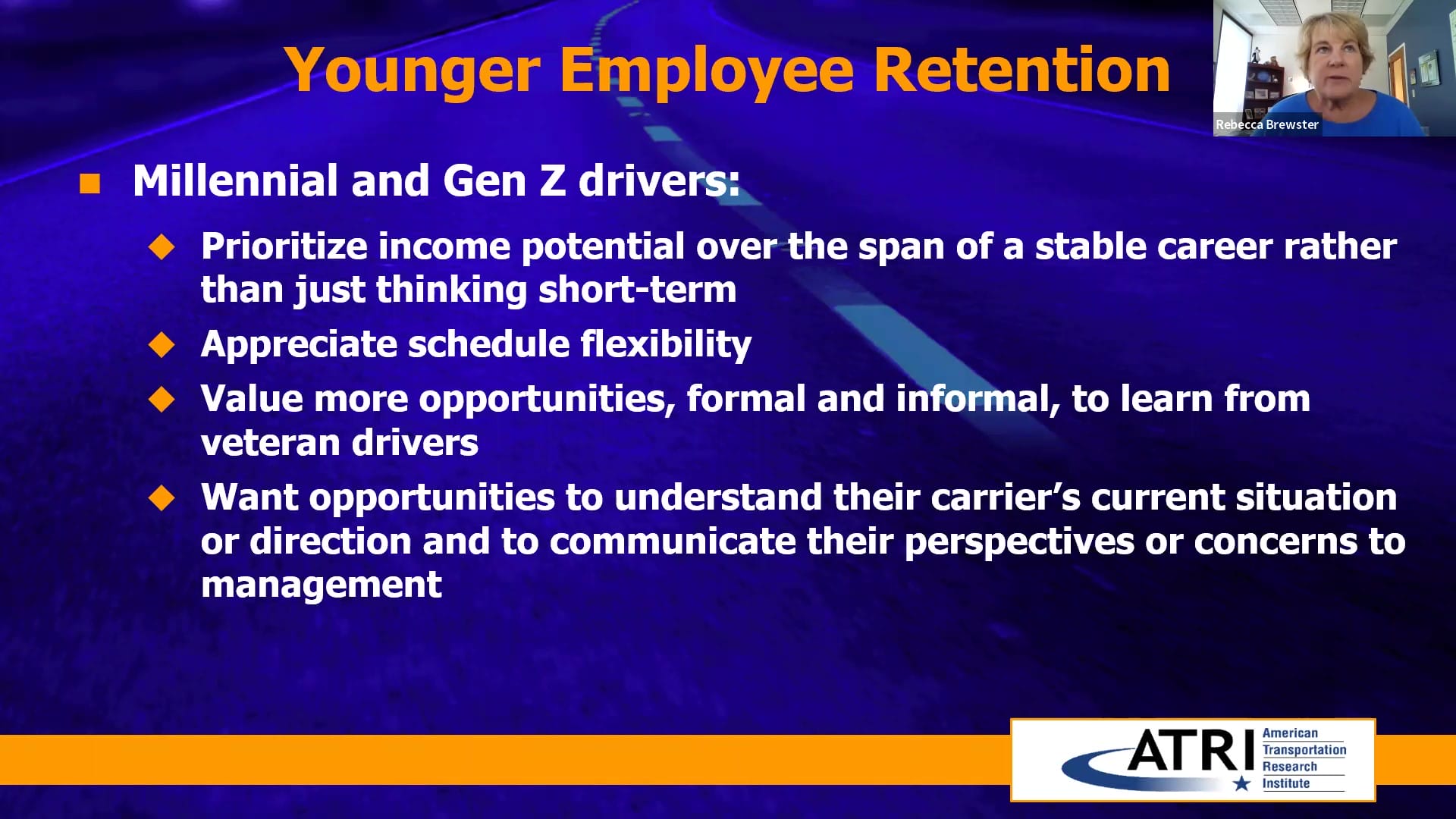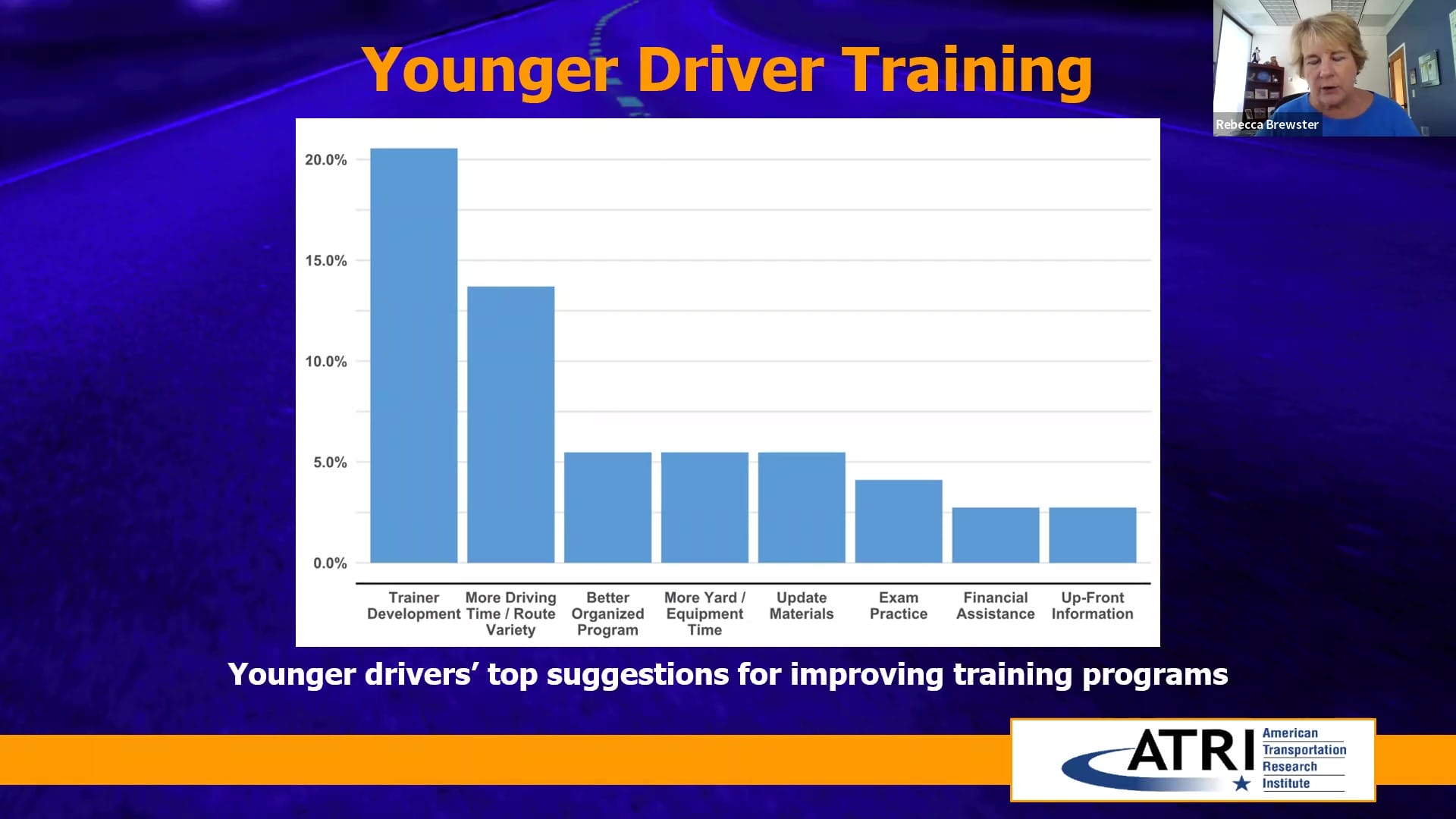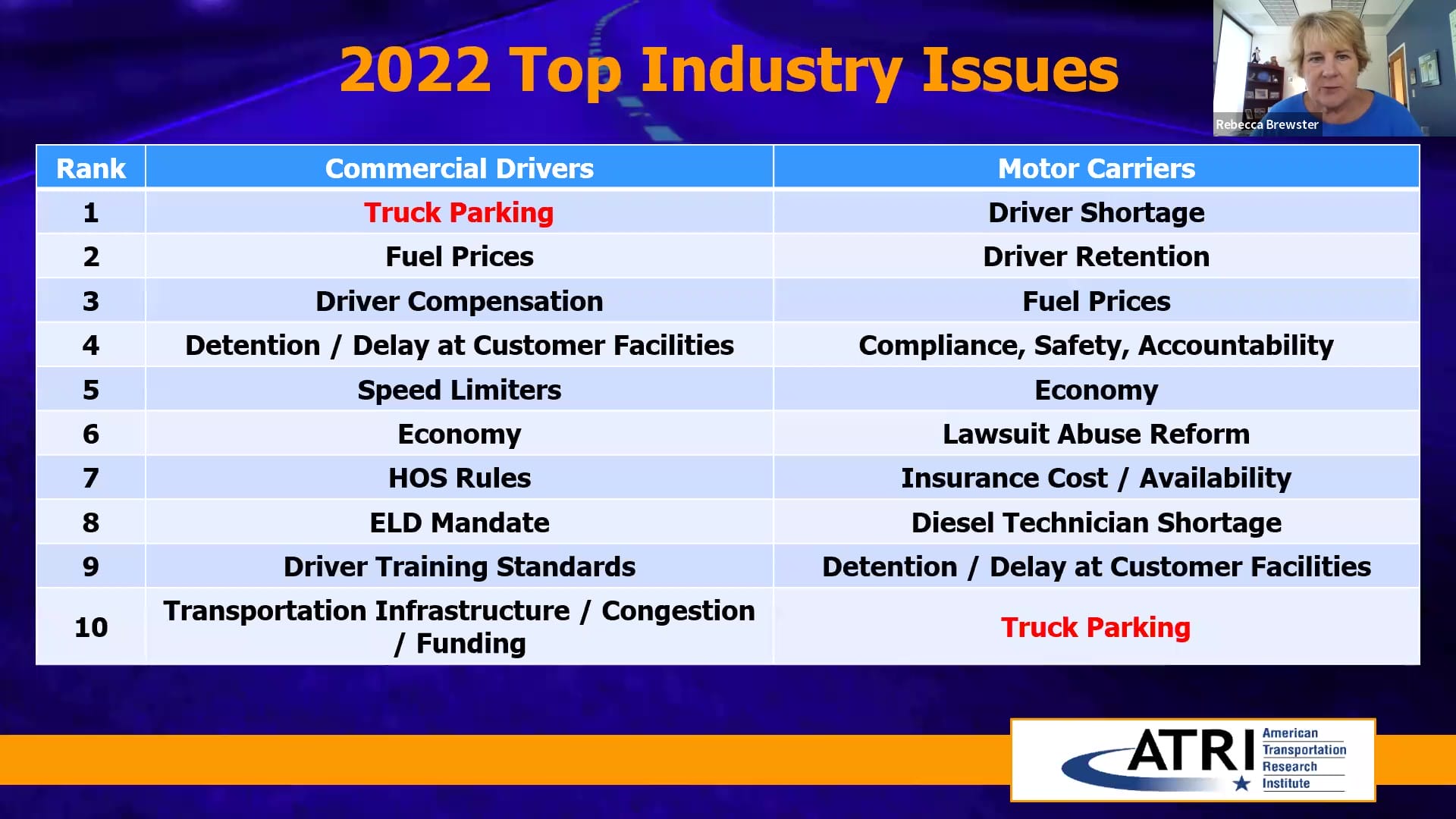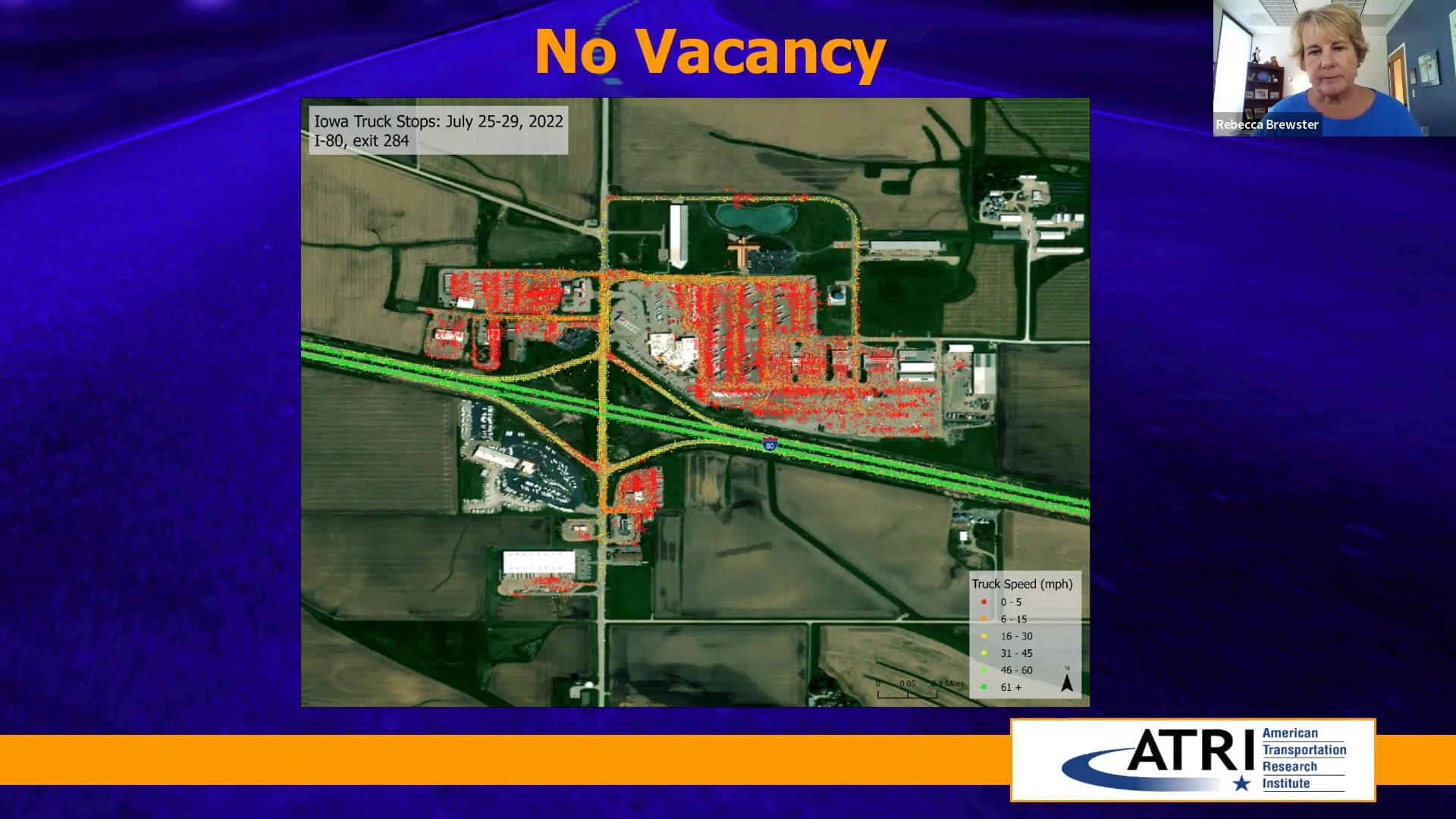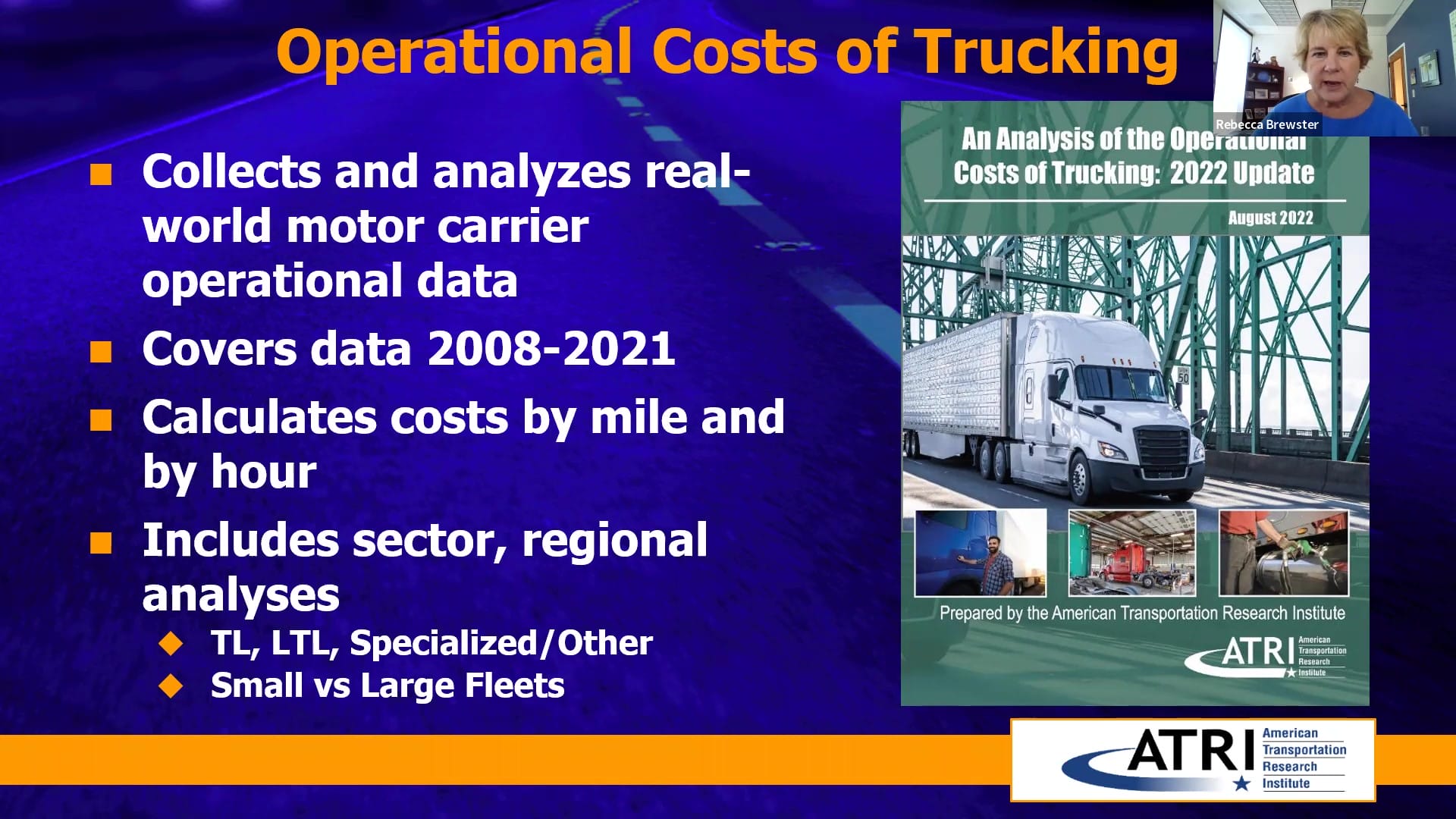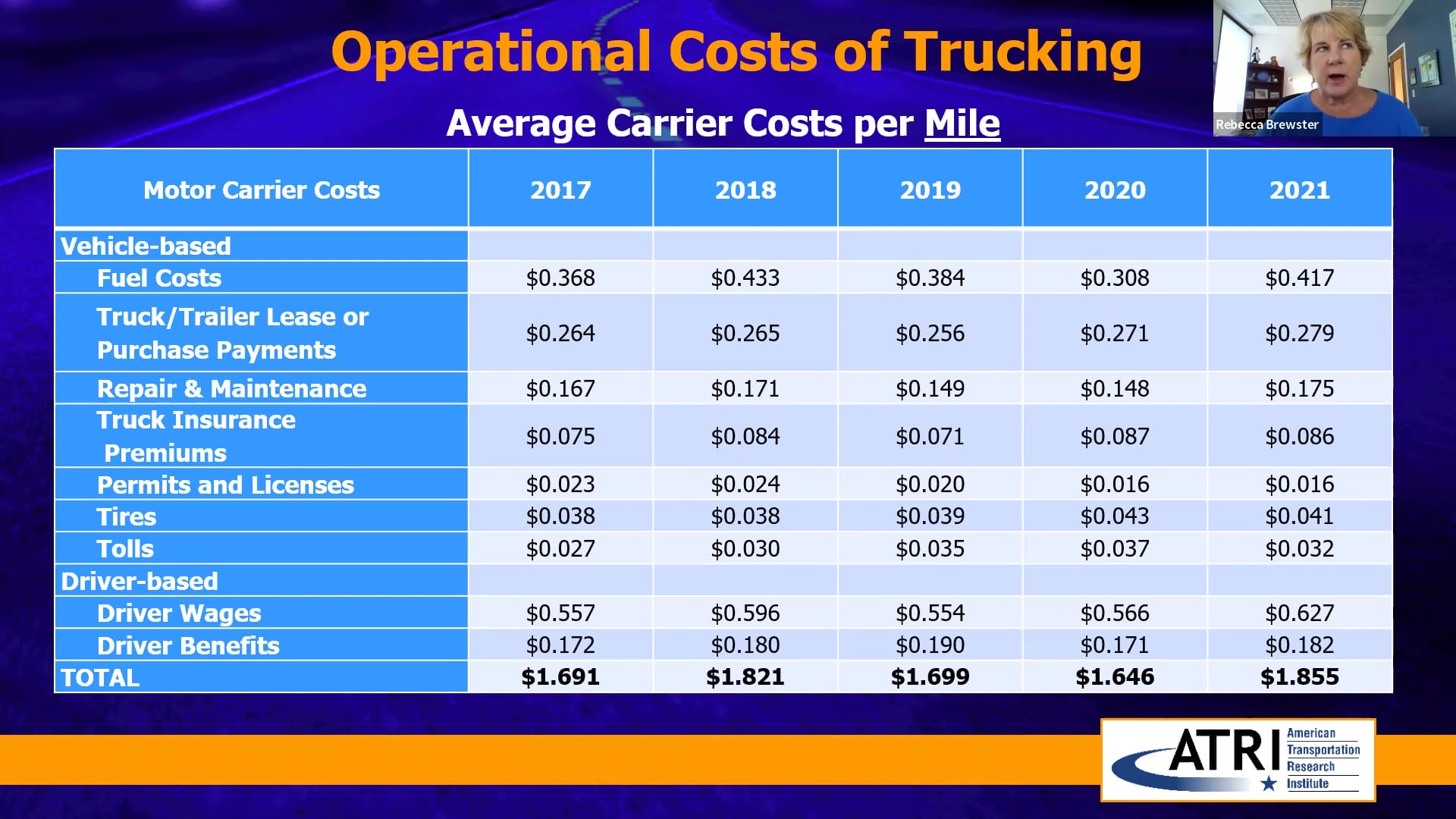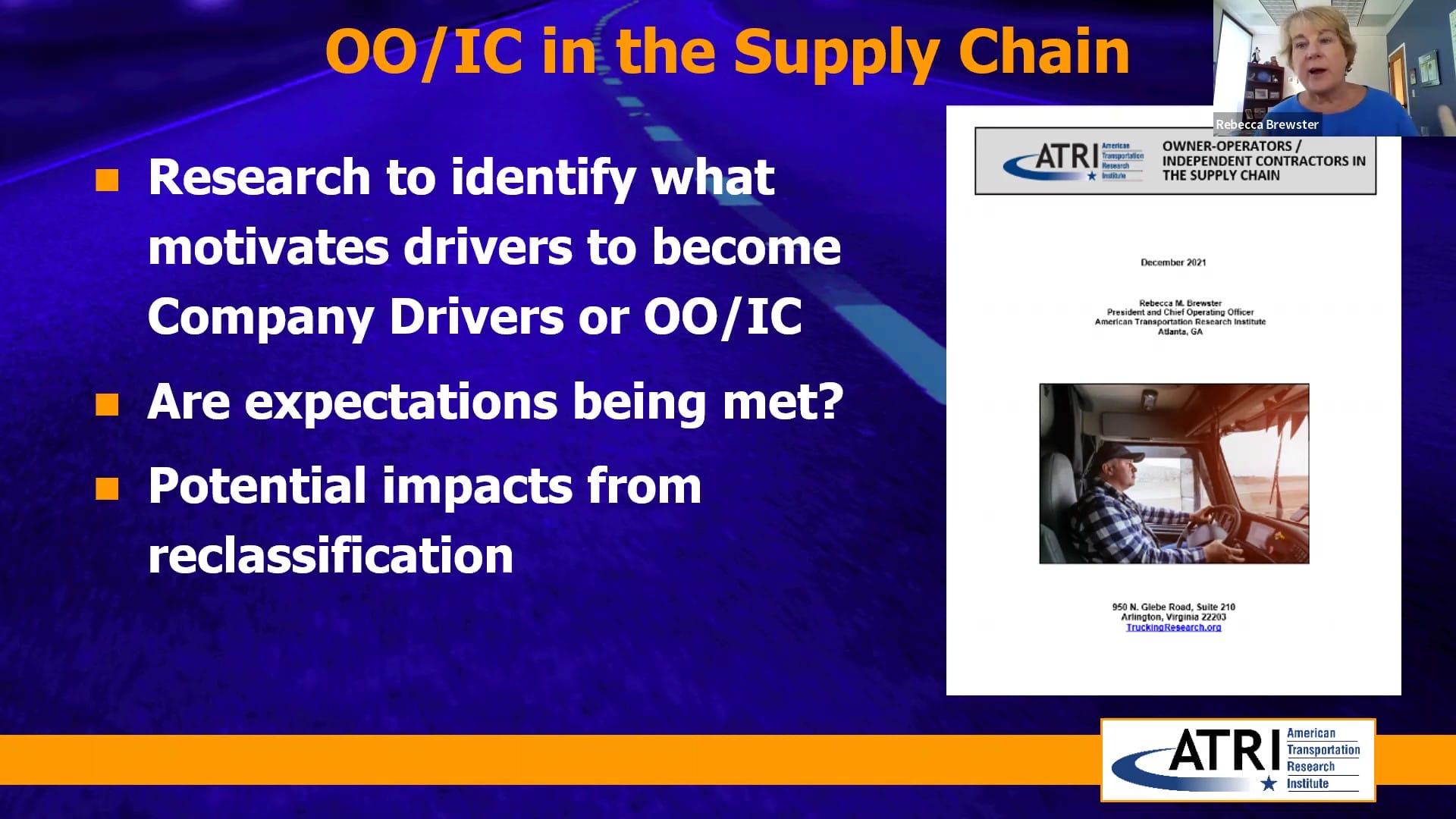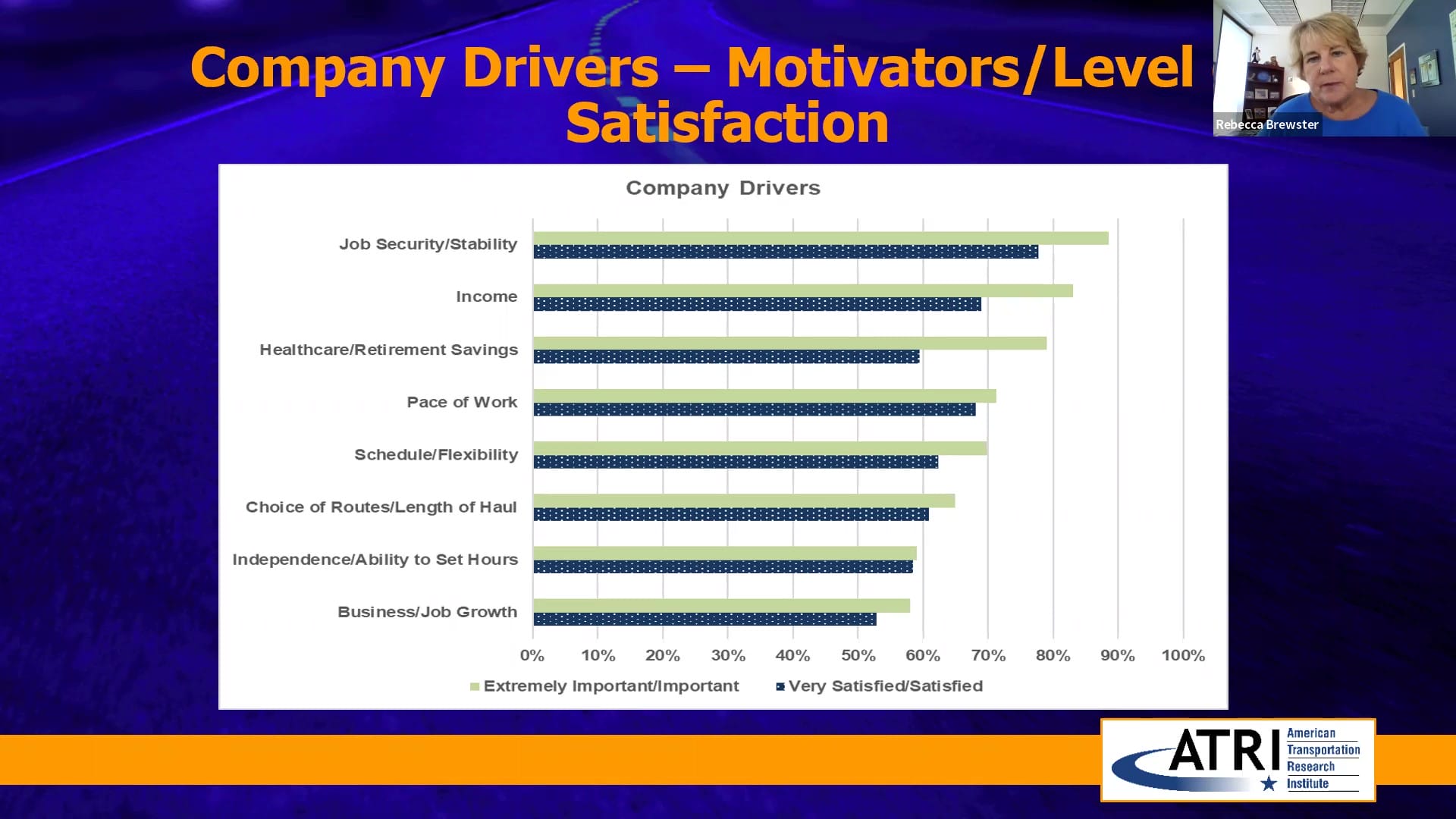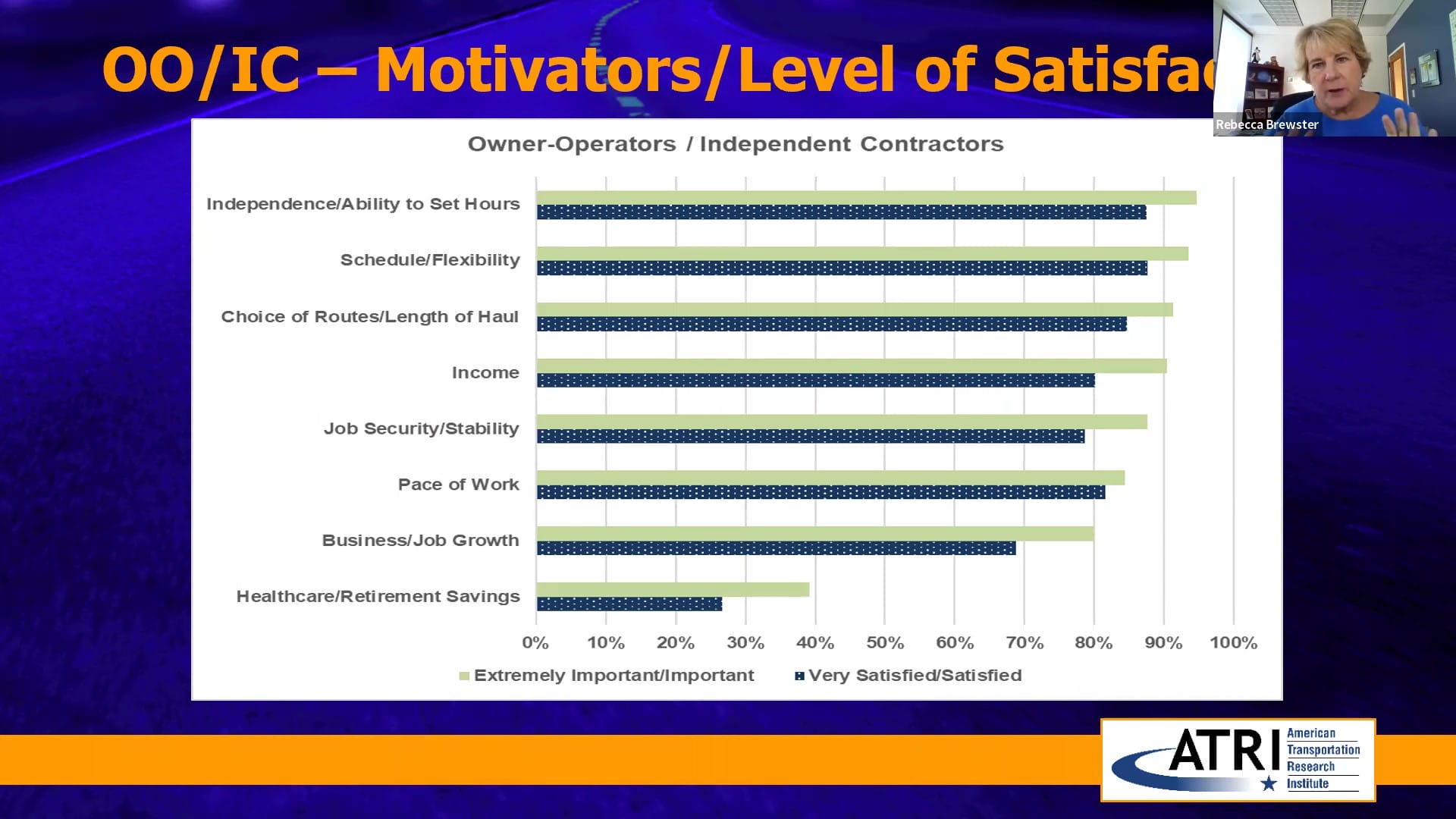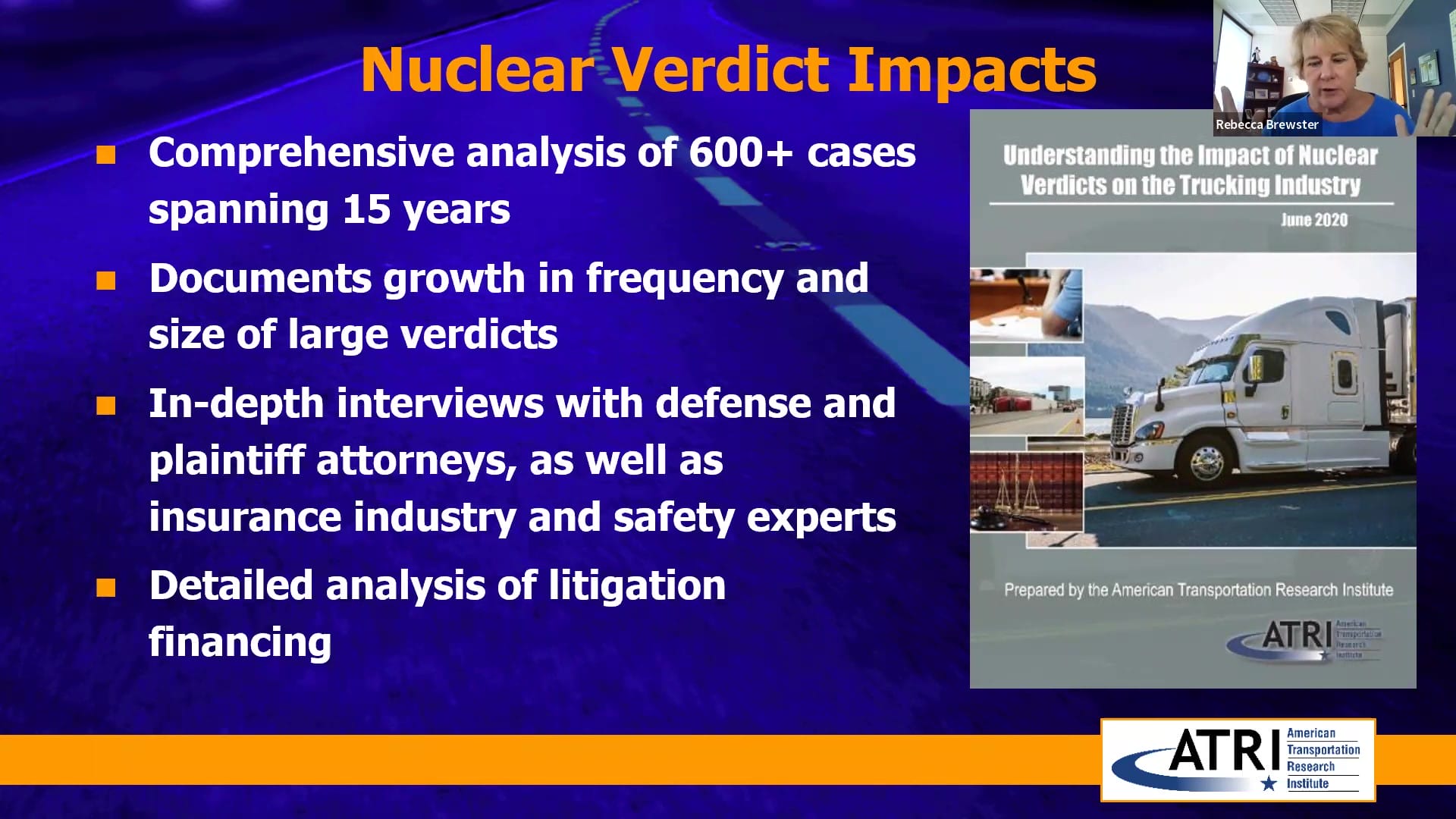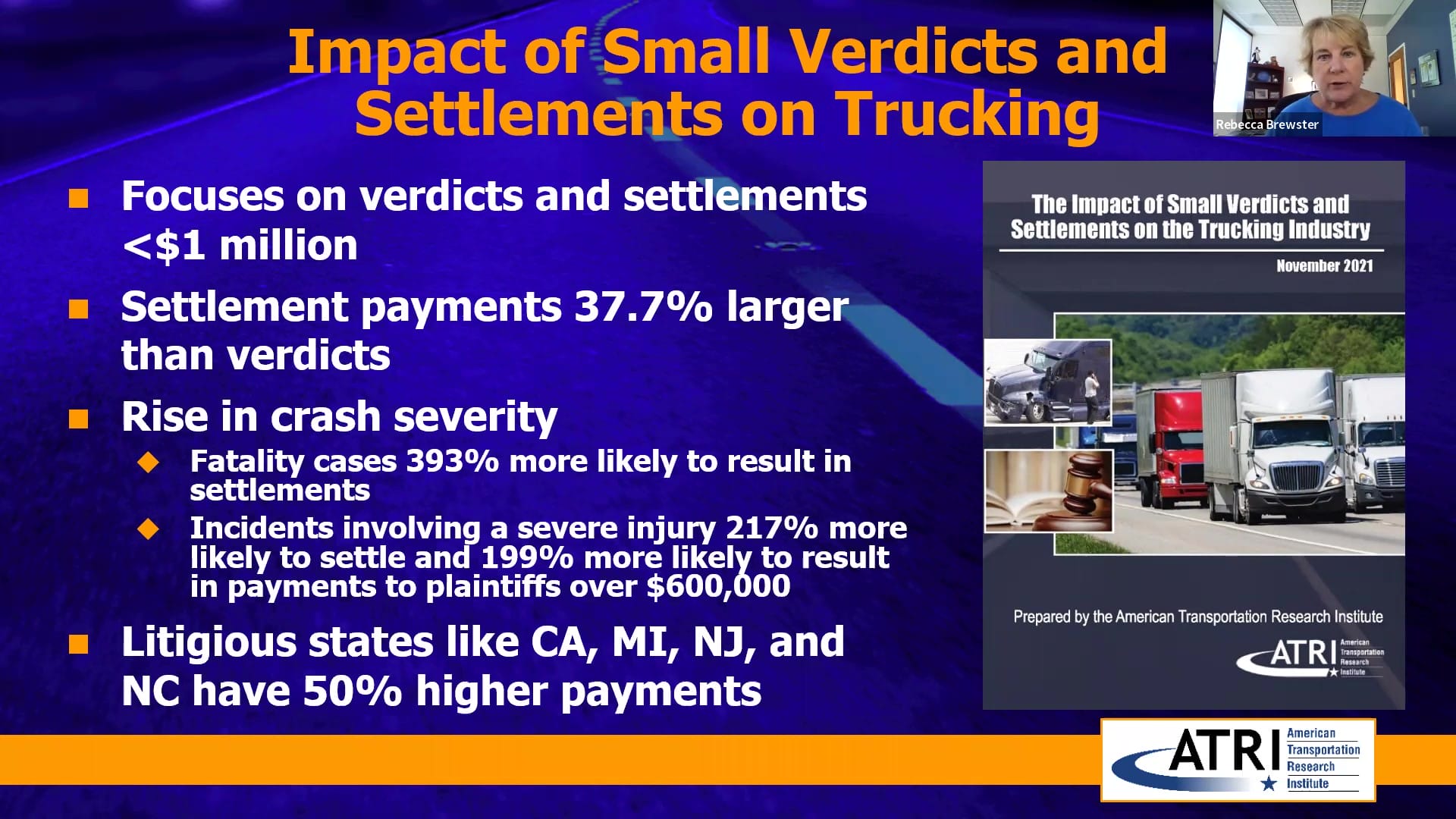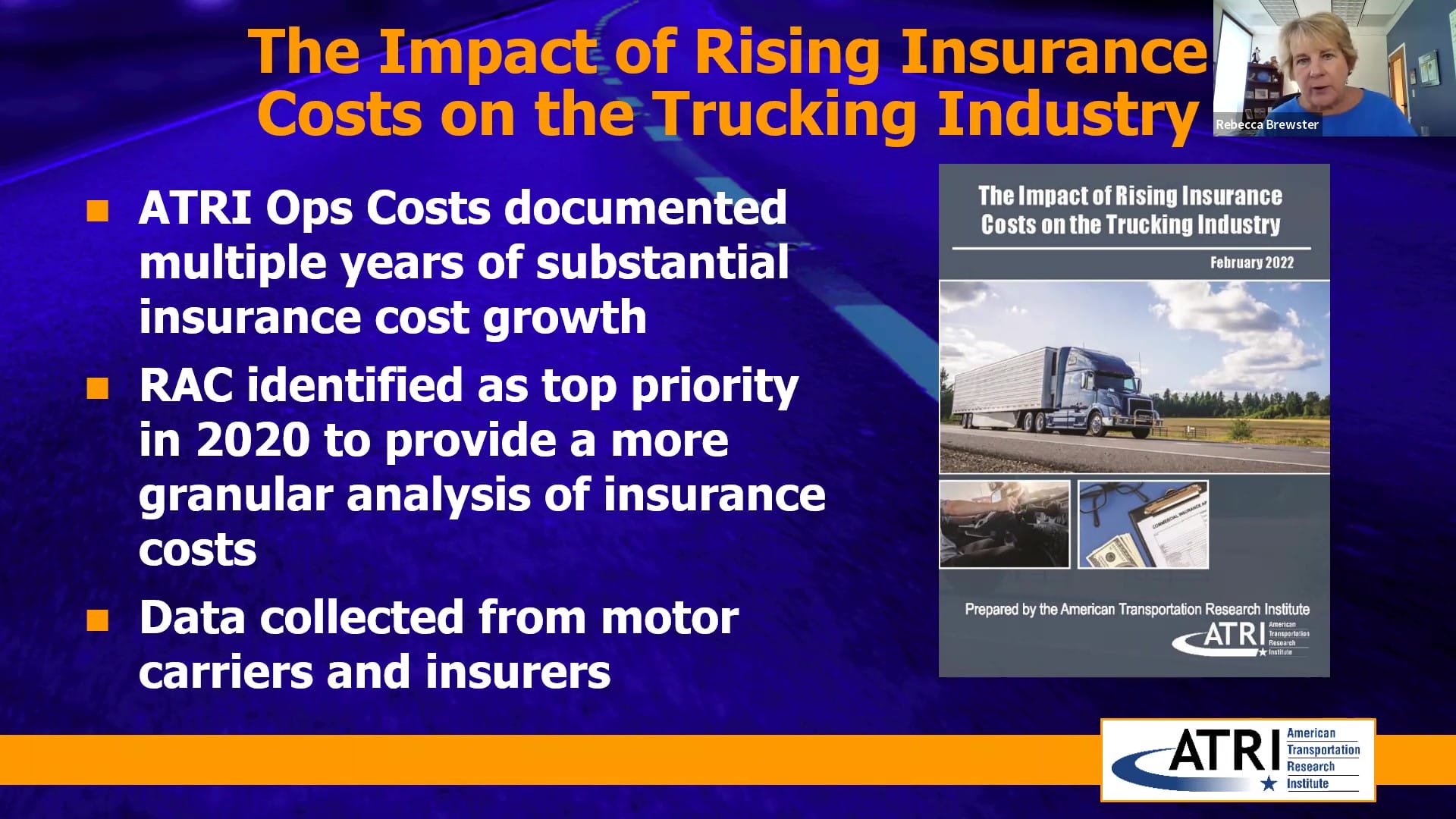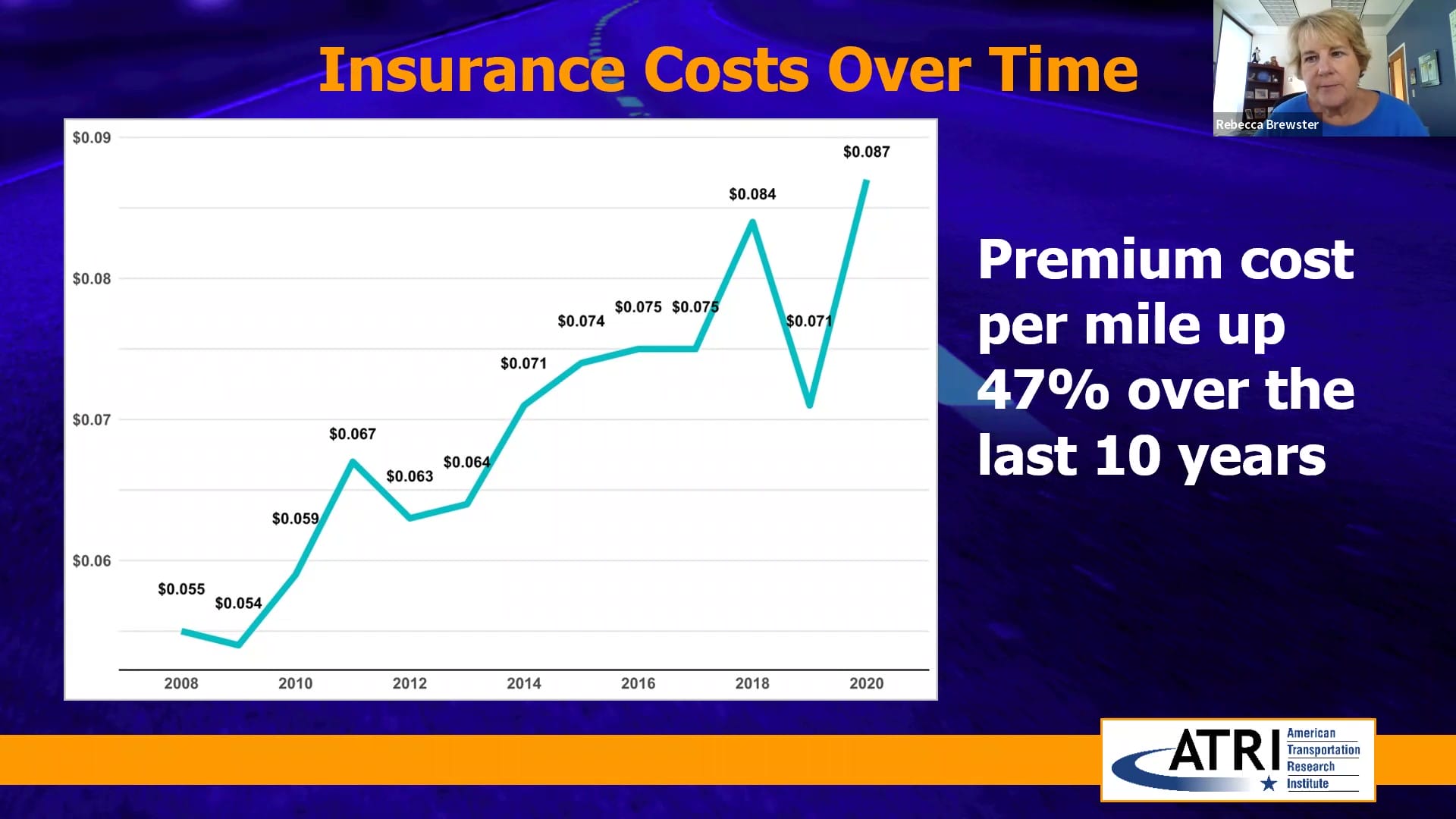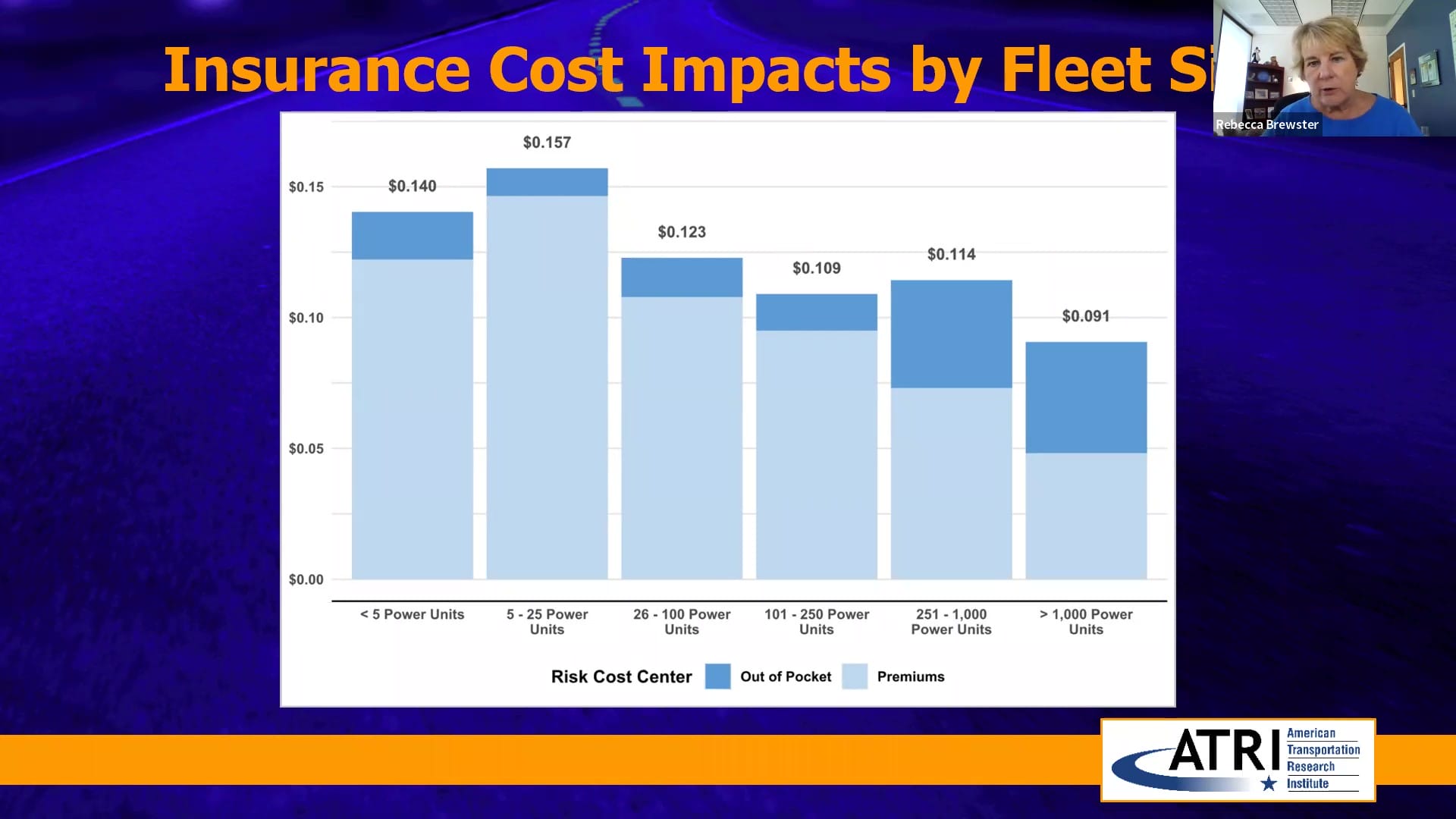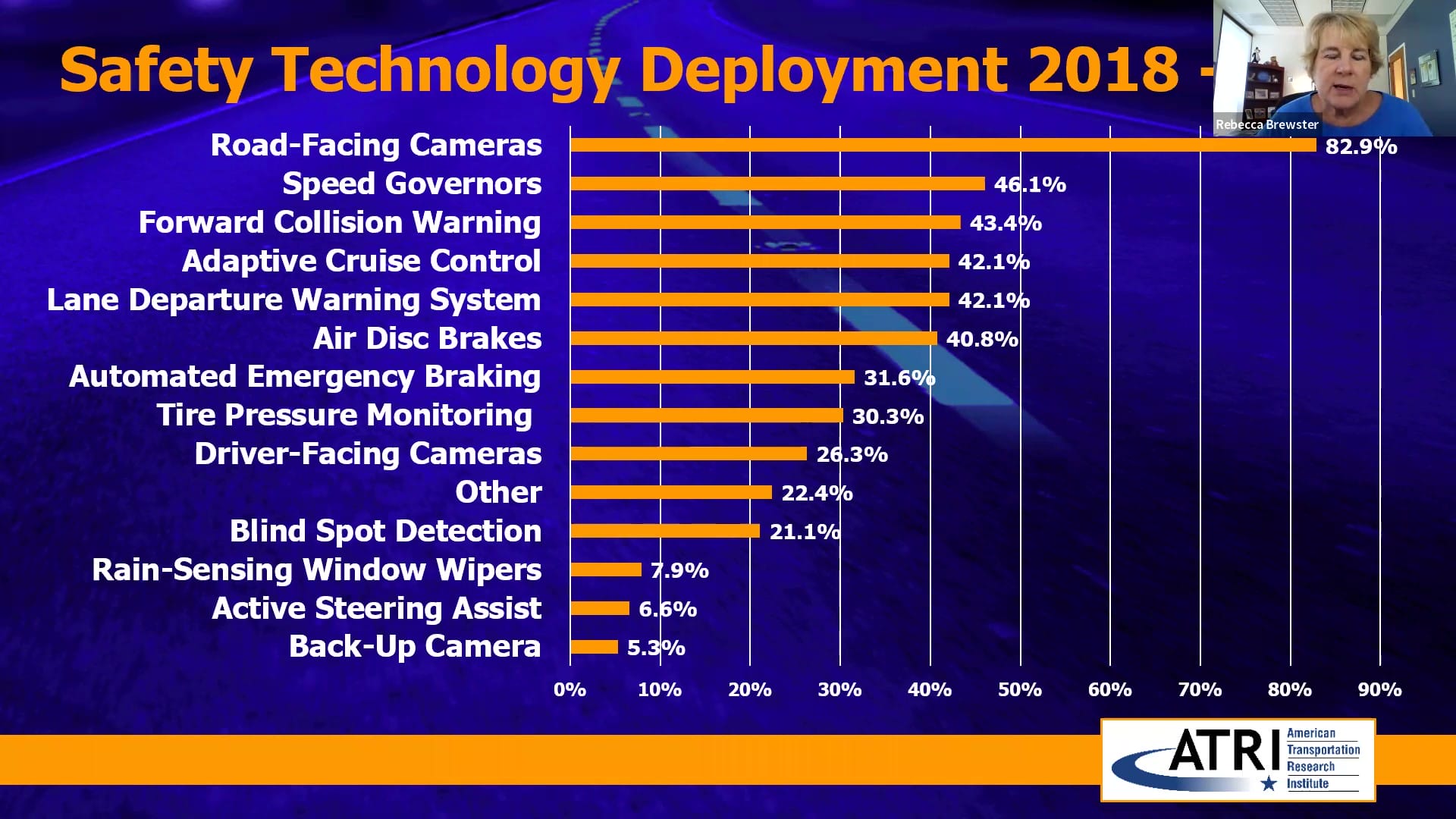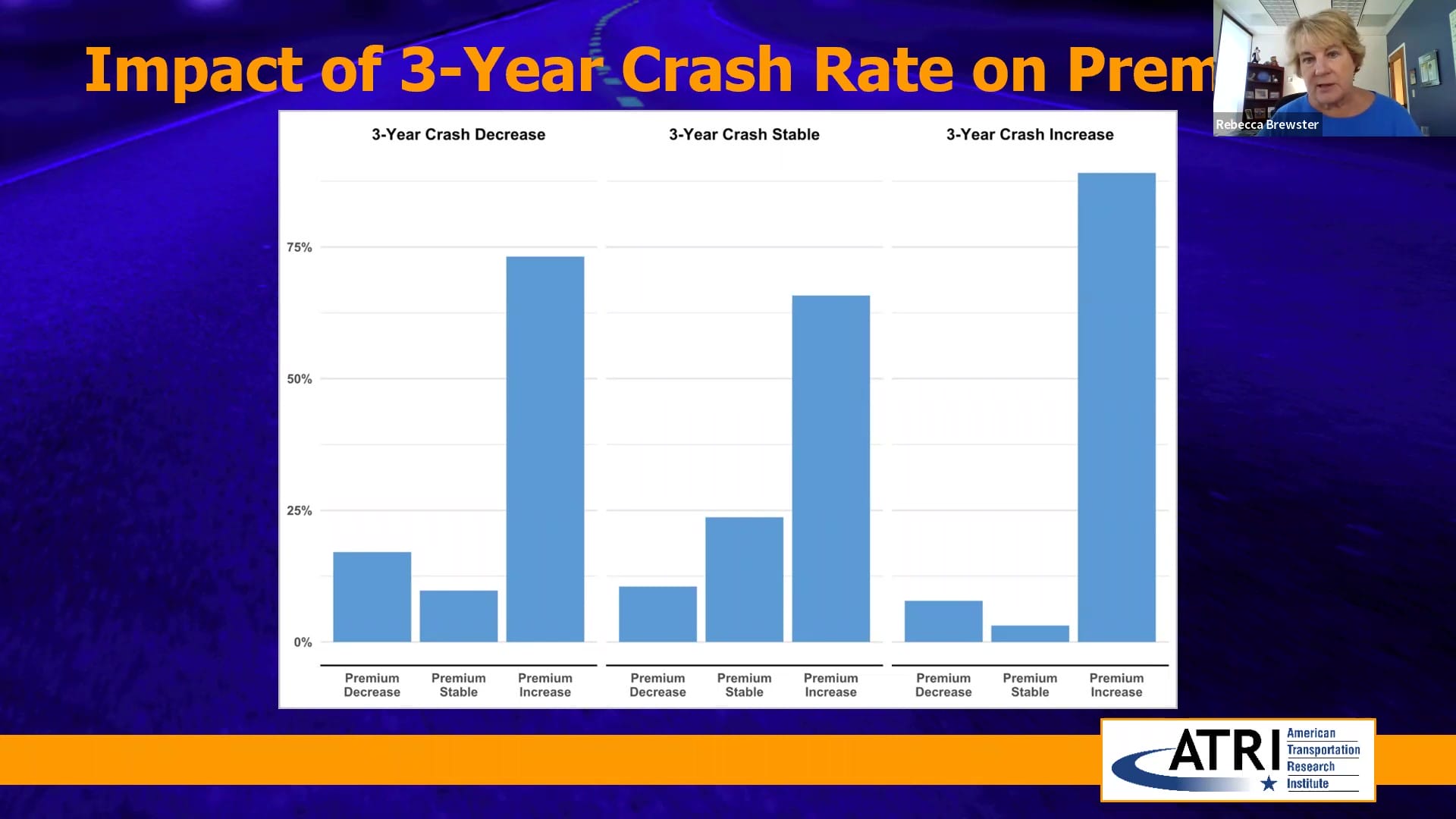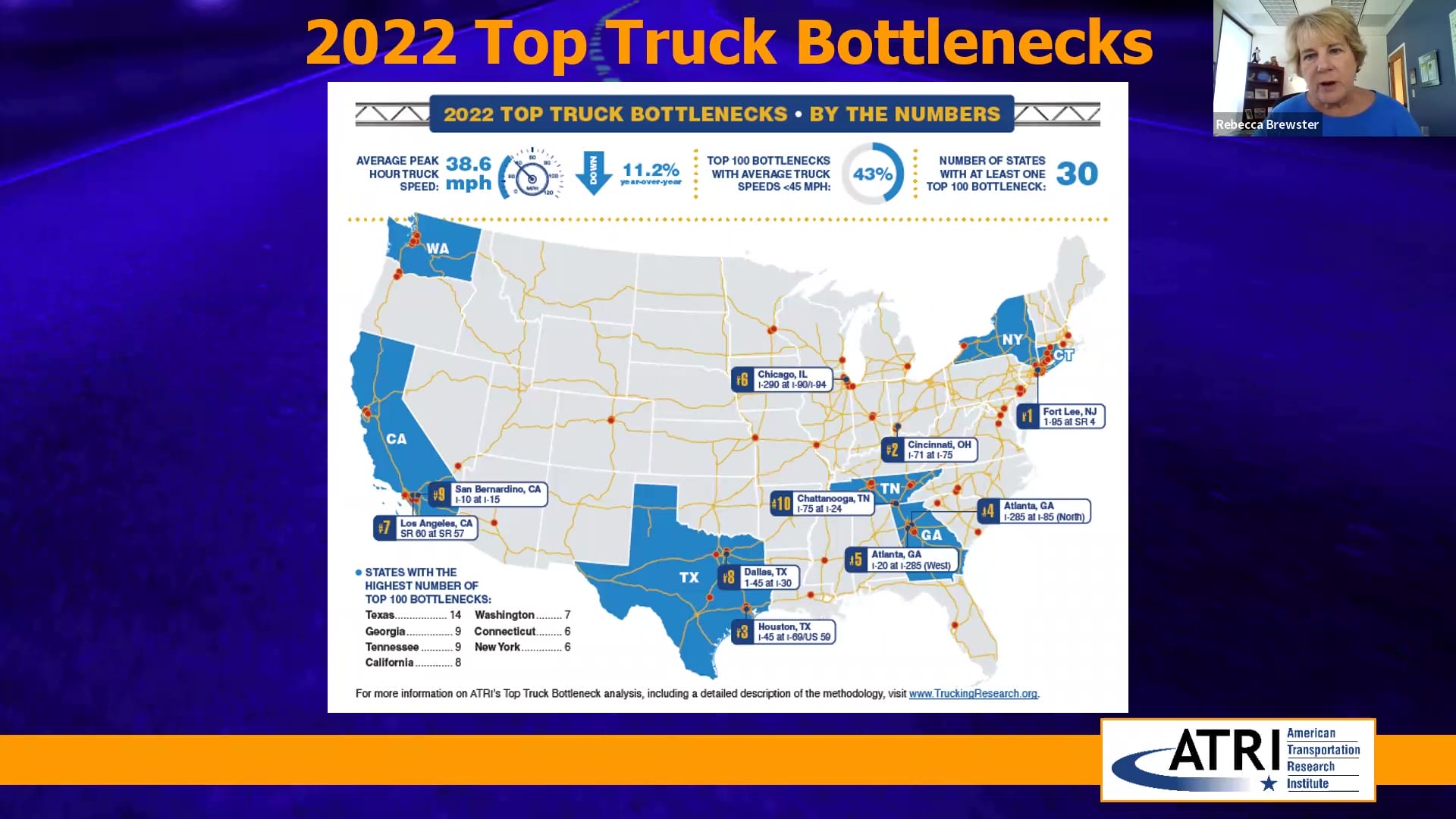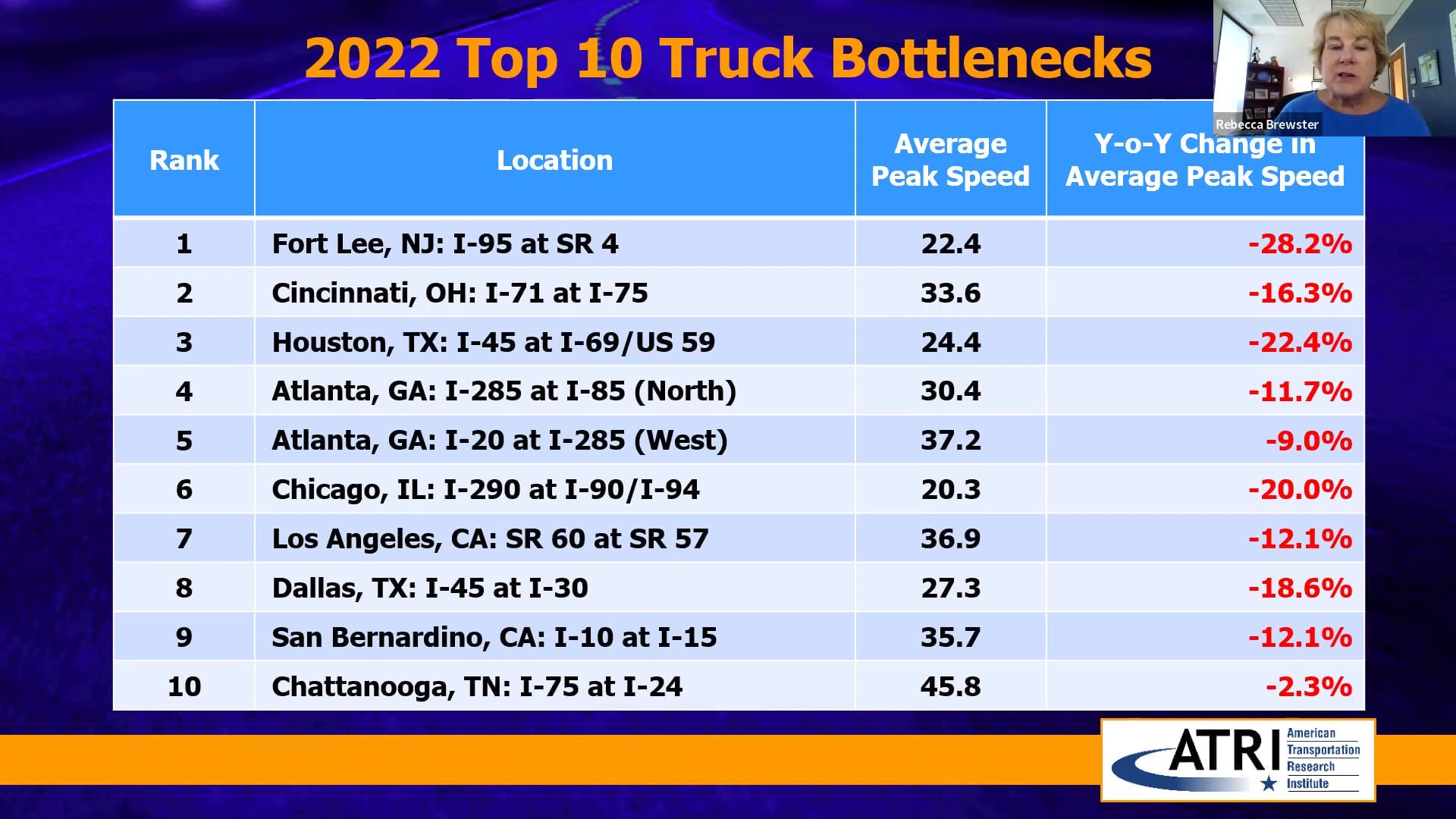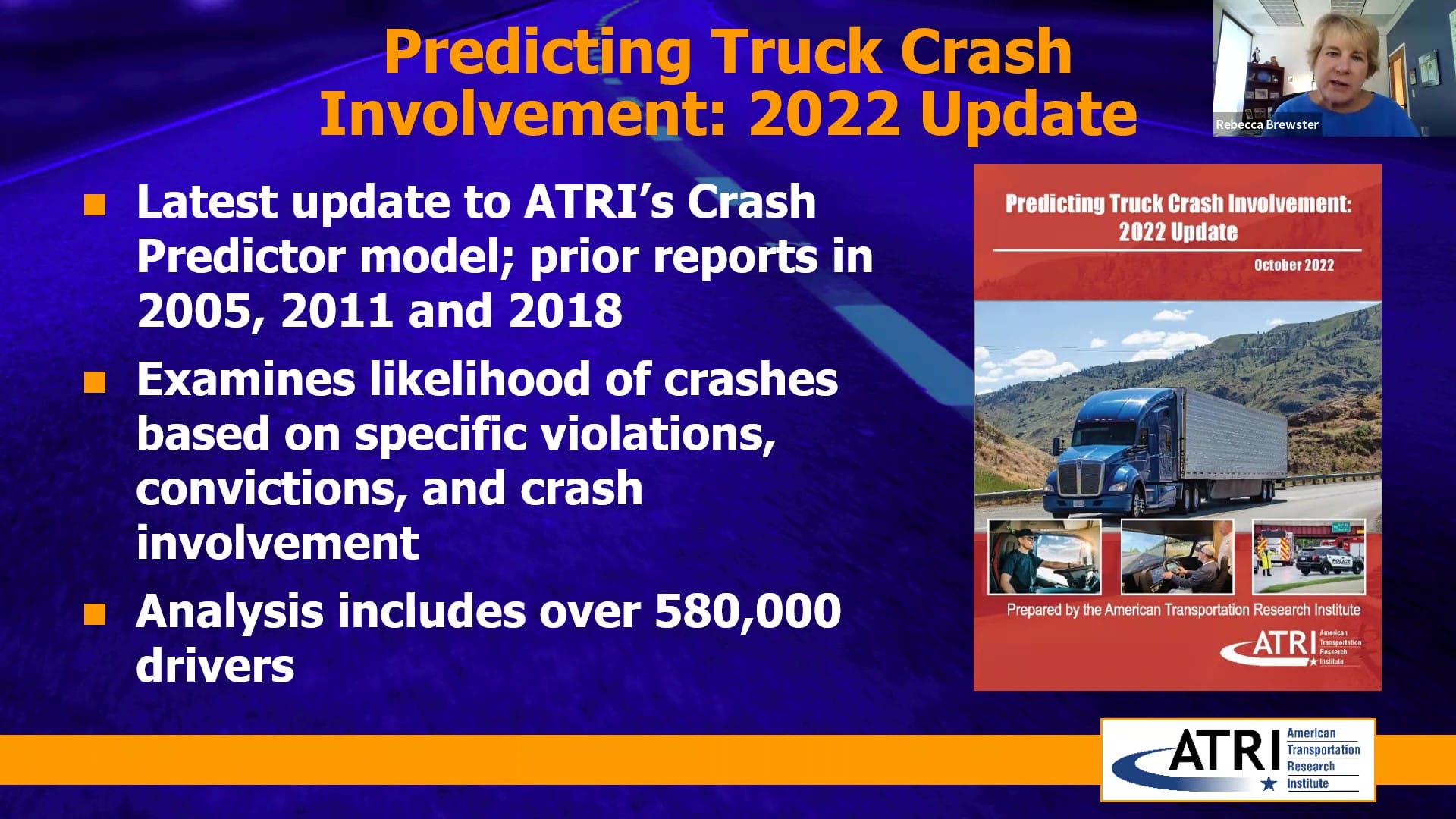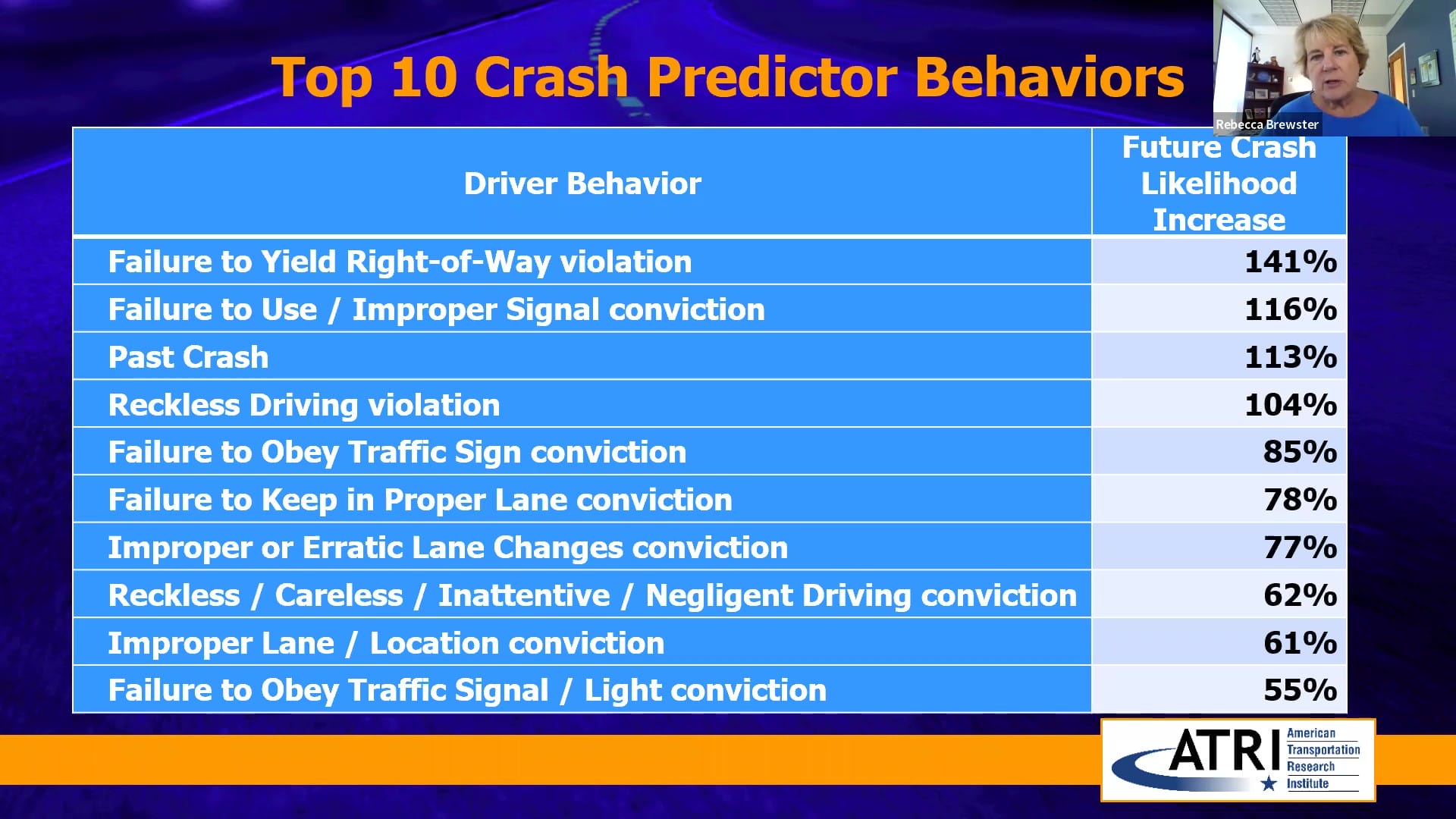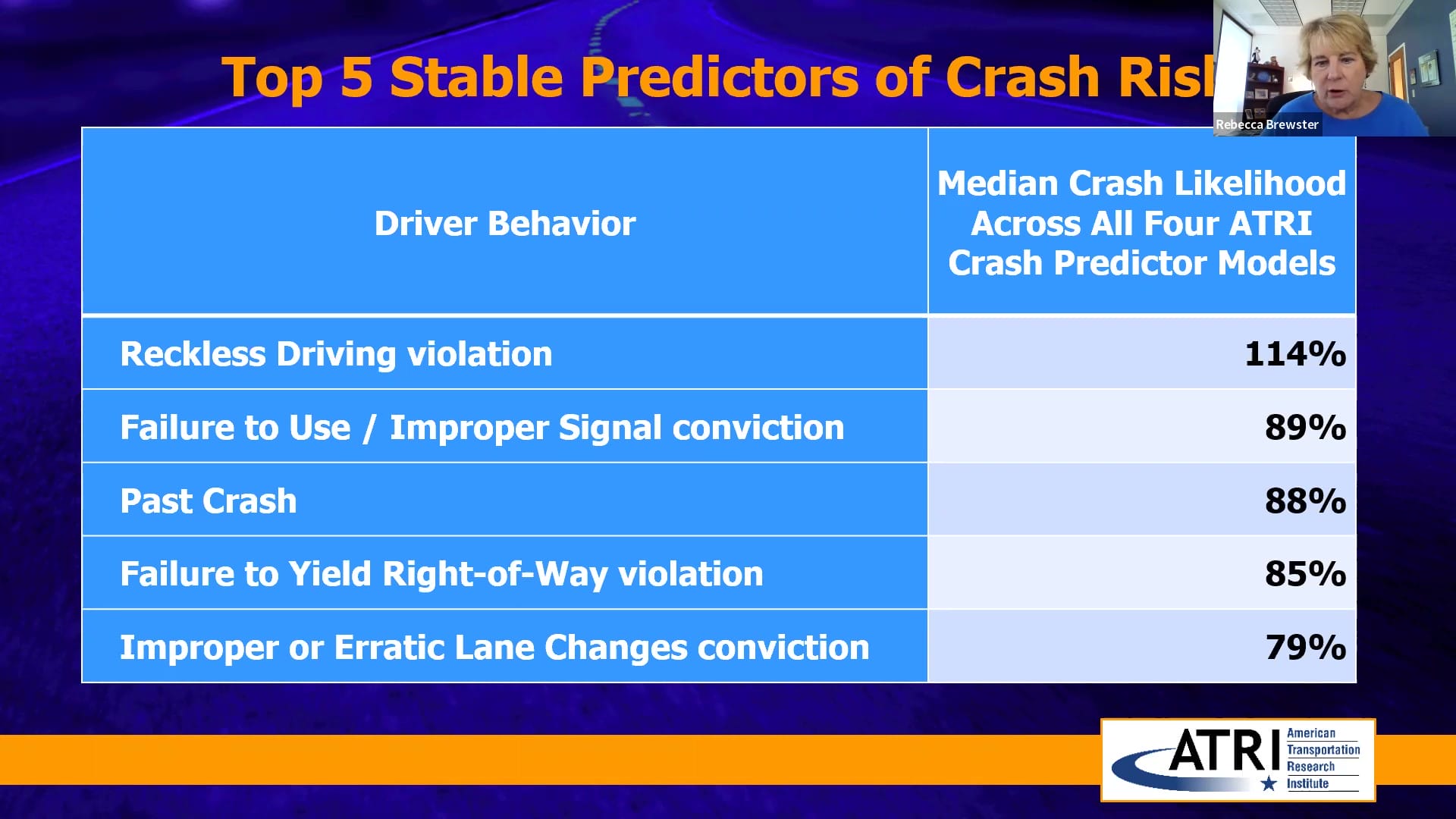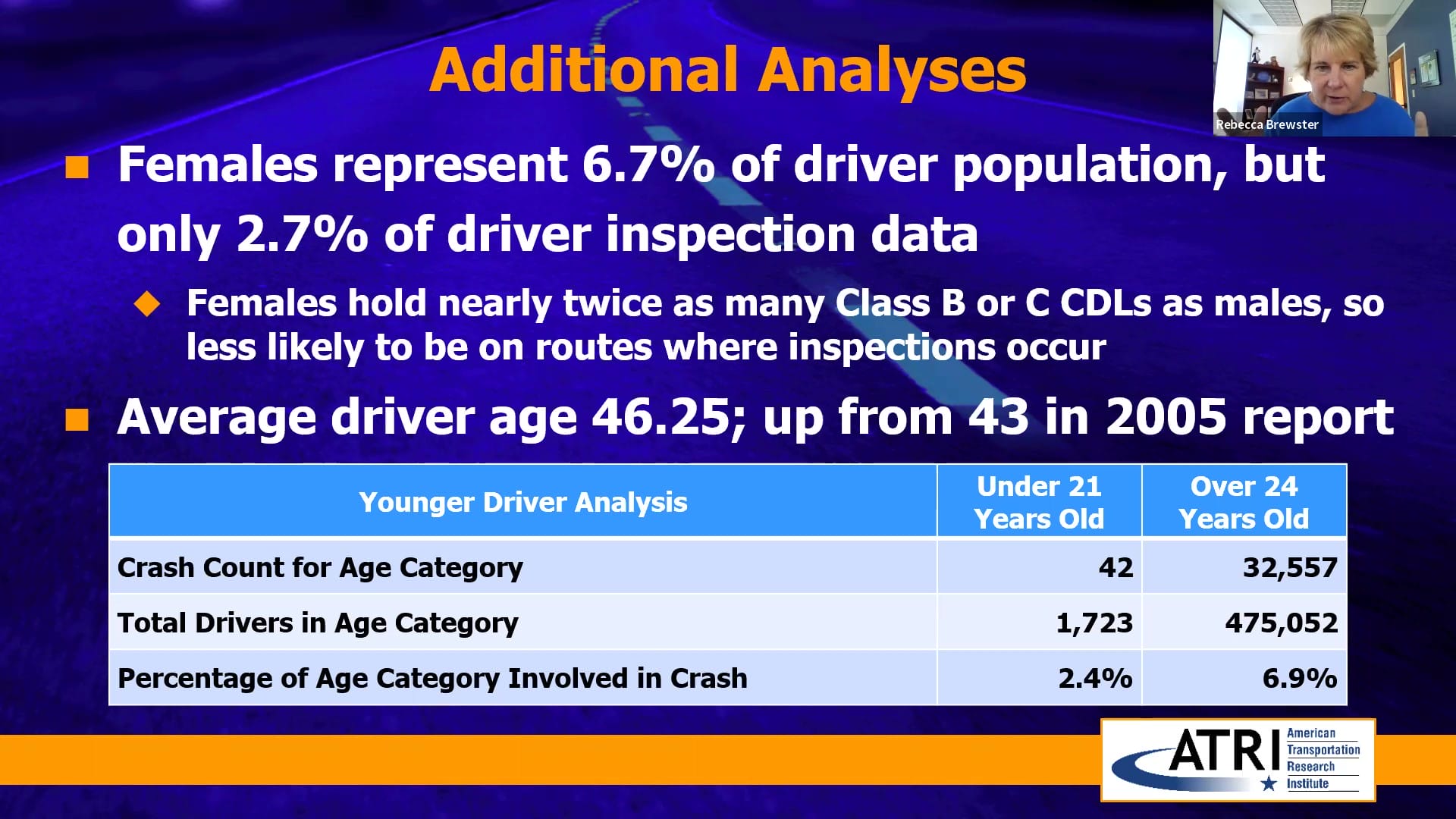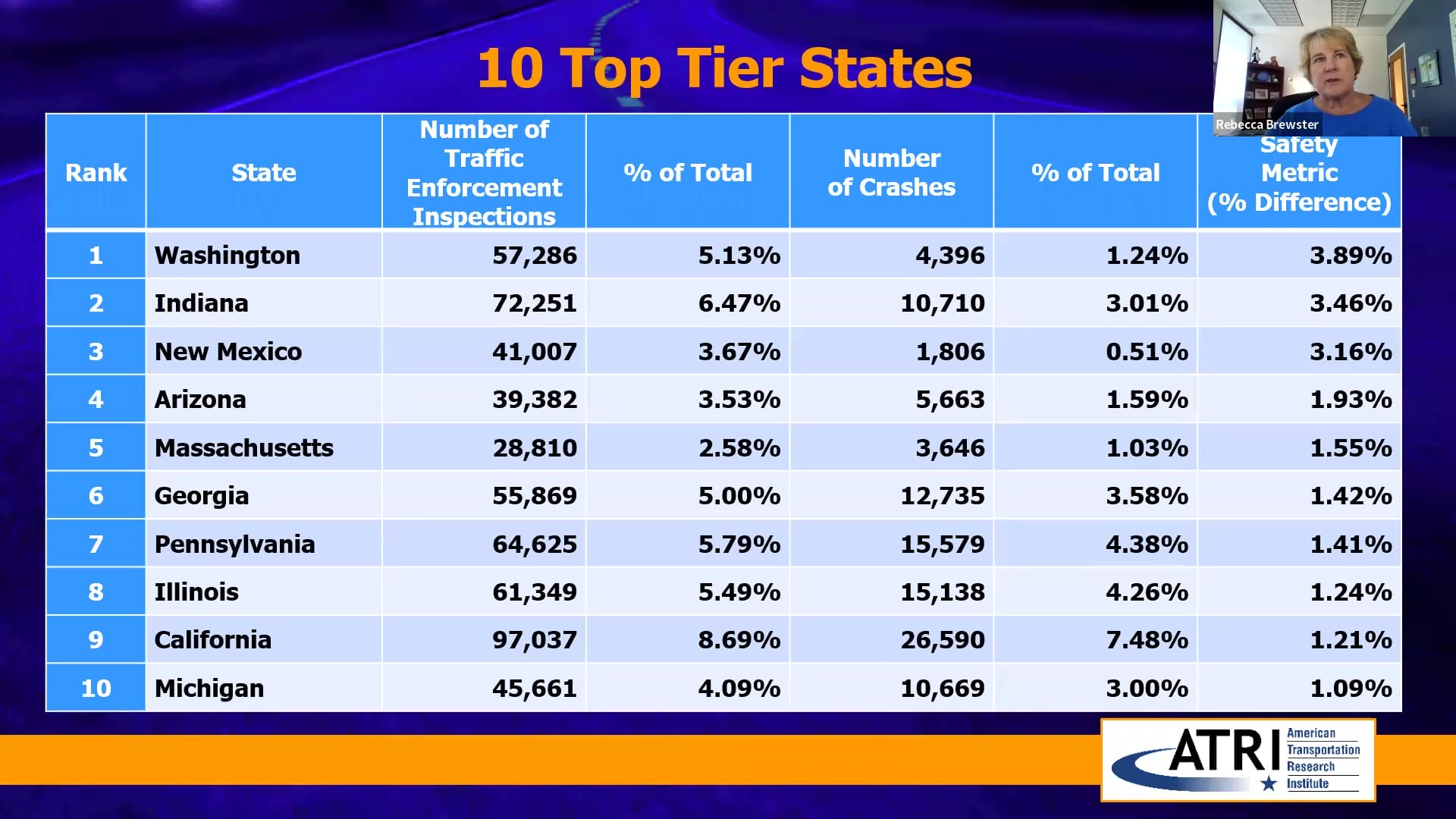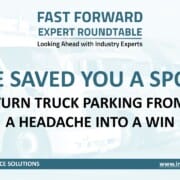Transcription
1
00:00:00.000 –> 00:00:01.320
Hosting our
2
00:00:02.700 –> 00:00:17.110
Mark Rhea: Good morning, this is Mark Rhea. Thank you for investing your time this morning to join our feature of the month, trucking top-10 talk tackling top industry issues. My name is Mark
3
00:00:17.120 –> 00:00:29.749
Mark Rhea: Rhea, and we are going to feature Mrs. Rebecca Brewster from the American Transportation Research Institute, and she has completed, and will be rolling out the top-10 if you haven’t seen it yet.
4
00:00:29.760 –> 00:00:42.660
Mark Rhea: Uh get ready. She’s got a lot of interesting information. Uh, if you haven’t the if you’ve got a few minutes, go ahead and and access your chat feature uh tell us where you’re calling in from.
5
00:00:43.210 –> 00:00:56.300
Mark Rhea: Uh. We want to hear from you a little bit about Infinit-I Workforce Solutions uh last month we delivered eight hundred thousand pieces of content to our driver community.
6
00:00:56.310 –> 00:01:13.280
Mark Rhea: Uh Since inception, Infinit-I, Workforce has delivered a hundred and twenty-five million pieces of content to our industry. It’s very obvious that the the platform, the learning, platform and Infinit-I Workforce that provides
7
00:01:13.290 –> 00:01:22.840
Mark Rhea: remote learning. Awareness training saves, lives, improves crash, frequency, and improves Csa violations.
8
00:01:23.360 –> 00:01:42.480
Mark Rhea: Uh, I’d also like to go ahead and and do a a preview that we will be offering a new uh uh improved Fuel Efficiency Series to all prospective and existing clients. We’ll have more information on that as we go through the series.
9
00:01:42.540 –> 00:01:43.729
Mark Rhea: Um,
10
00:01:44.060 –> 00:01:48.390
Mark Rhea: I want to go ahead and get straight into the Uh to the program
11
00:01:49.440 –> 00:02:08.209
Mark Rhea: at Ri. The American Transportation Research Institute was established in one thousand nine hundred and fifty-four, and it is the absolute authority and recognized by institutions, including legislation, legislative enforcement, environmental academic financial and of course, all the motor carriers
12
00:02:08.509 –> 00:02:17.230
Mark Rhea: uh today, and it is also a nonprofit organization, I might add, and they would be. I’m sure Rebecca will be glad to, uh
13
00:02:17.380 –> 00:02:24.489
Mark Rhea: make available to you the opportunity to make contributions, since they do per depend on our industry.
14
00:02:24.940 –> 00:02:25.890
Mark Rhea: So
15
00:02:26.160 –> 00:02:37.090
Mark Rhea: without any further, do I know you didn’t dial in to listen to me. But we will talk to Miss Rebecca Brewster. She’s the president, chief operating officer of the at R. I.
16
00:02:37.170 –> 00:02:52.700
Mark Rhea: She was recognized by Fleet Owner Magazine in two thousand and sixteen as the dozen outstanding women in trucking, and in two thousand and thirteen received the award influential women in trucking for the women and Trucking association.
17
00:02:52.710 –> 00:03:03.440
Mark Rhea: She’s well known throughout our industry. She represents us very professionally on a multitude of of issues. Rebecca. The floor is yours.
18
00:03:03.910 –> 00:03:13.879
Rebecca Brewster: Well, Mark, thank you very much. I really appreciate the opportunity to join you today and and talk through the trucking Industry’s top ten, And, Colin, if we can advance to the next slide.
19
00:03:15.050 –> 00:03:30.000
Rebecca Brewster: And actually we can go to the next one. Thank you. So I hope everyone is is familiar with. Actually, we are the trucking industries, not for profit research organization, and most of the work that we do on your behalf is generally focused in the areas. You see here.
20
00:03:30.010 –> 00:03:47.200
Rebecca Brewster: One of the hallmarks of battery is that we provide all of our research free of charge. And so I’ve listed my website address here, trucking research, Org. I’ll put it up again at the end. But if you see a study today that you are particularly interested in, you can go and download that study at no cost two hundred.
21
00:03:47.210 –> 00:04:03.839
Rebecca Brewster: And, as Mark indicated, we are a five hundred and one, c. Three charitable research organization. So if you see value in the work that actually does on behalf of the trucking industry. We would certainly welcome a charitable contribution from you personally or from your organization next slide.
22
00:04:04.800 –> 00:04:15.950
Rebecca Brewster: And actually we are governed by a board of directors made up of the Ceos of the organizations. You see here, our current chair is Derek Leathers, the the Chairman of Warner Enterprises,
23
00:04:16.010 –> 00:04:17.650
Rebecca Brewster: that next slide,
24
00:04:20.290 –> 00:04:35.980
Rebecca Brewster: and where the however, where the the real heavy work gets done it Atry is the members of our Research advisory committee. And so the men and women that represent the organizations you see here are charged with annually identifying the trucking Industry’s Top research needs one hundred and fifty
25
00:04:36.340 –> 00:04:55.129
Rebecca Brewster: This group and their predecessors gets together once a year every march. They typically review some twenty-five to thirty different research proposals, and after a very thorough vetting of each of those proposals, and the value each would bring to the industry. They vote and come up with a list of the top
26
00:04:55.220 –> 00:05:10.390
Rebecca Brewster: typically five to eight studies that actually will focus on over the next year. And what’s so compelling about this group is, is it’s? Make up in terms of representation in the industry. We have both uh large trucking fleets and small trucking fees.
27
00:05:10.520 –> 00:05:26.900
Rebecca Brewster: We have uh driver groups represented both O. Id and the teamsters are represented. We have law enforcement, government representation truck stop operators. It really is a very diverse group of trucking industry stakeholders next slide
28
00:05:31.320 –> 00:05:48.809
Rebecca Brewster: one of the key inputs that the Research Advisory Committee uses when determining what research needs to be done for the industry is our annual survey. What we call our top industry issues survey, and, as Mark indicated, we just released the two thousand and twenty-two results of the top industry issue survey
29
00:05:48.850 –> 00:06:01.650
Rebecca Brewster: So we started the survey in two thousand and five. We go out to the industry at large. Uh it doesn’t take you long to take the survey. I hope everyone has already participated in it. It some year, and and hopefully this most recent one
30
00:06:01.660 –> 00:06:15.499
Rebecca Brewster: you’re presented with a list of of critical issues in the industry. You are asked to pick your top three. And then for each of those three you’re asked to rank potential strategies that you think the industry should collectively be pursuing.
31
00:06:15.590 –> 00:06:24.640
Rebecca Brewster: We had our largest response to date. Uh, in this year’s survey we had over four thousand two hundred trucking industry. Stakeholders participate in the survey,
32
00:06:24.660 –> 00:06:43.720
Rebecca Brewster: and we had a new top ten issue um a new number one issue, I should say, with fuel prices, and uh, to the right of each issue you can see where it ranked in the previous year’s survey, so we had not seen fuel prices in the top Ten issues
33
00:06:43.730 –> 00:06:47.329
Rebecca Brewster: uh since two thousand and thirteen, when it ranked eighth overall.
34
00:06:47.460 –> 00:06:54.230
Rebecca Brewster: The driver. Shortage had been our annual Pop History issue for five years in a row before this year.
35
00:06:54.460 –> 00:06:57.700
Rebecca Brewster: Uh, but it was supplanted by fuel prices
36
00:06:57.750 –> 00:07:12.839
Rebecca Brewster: from parking rose two spots this year to be the number three overall issue driver, compensation number four, and then another issue. We hadn’t seen in a couple of years. The state of the nation’s economy coming in at Number Eight overall.
37
00:07:12.920 –> 00:07:30.269
Rebecca Brewster: One other note on the top ten list you’ll see Number nine is speed limiters, and we know that this year, on two thousand and twenty-two earlier this year, Fmcsa issued a a notice of intent to enter into a speed limiter rule making in two thousand and twenty-three,
38
00:07:30.280 –> 00:07:35.480
Rebecca Brewster: and so a lot of concern on the part of uh, particularly drivers uh
39
00:07:35.610 –> 00:07:39.449
Rebecca Brewster: for what that speed limit or rulemaking might look like
40
00:07:40.060 –> 00:07:41.300
Rebecca Brewster: next slide.
41
00:07:42.700 –> 00:08:01.840
Rebecca Brewster: So uh, those are the overall results. This is what it looks like when you break out. How motor carriers rank the issues versus how commercial drivers rank the issues, and on the motor carrier side side not surprising. Each year we see the same thing, number two top two issues, finding and keeping drivers.
42
00:08:01.940 –> 00:08:18.729
Rebecca Brewster: And uh, what I always like to remind folks motor carriers is. If your top concerns are finding and keeping drivers, then you really need to understand and do what you can to impact those issues that professional drivers say concern them the most,
43
00:08:18.740 –> 00:08:24.450
Rebecca Brewster: and number one for the third year in a row for professional drivers, the lack of available truck, parking,
44
00:08:24.570 –> 00:08:30.310
Rebecca Brewster: fuel prices, number two and number three for drivers uh driver compensation.
45
00:08:30.730 –> 00:08:31.890
Rebecca Brewster: Next slide.
46
00:08:35.460 –> 00:08:52.899
Rebecca Brewster: I mentioned that the the first year we did. This was in two thousand and five, and I just thought it was fascinating some eighteen years later. Here we are, same top two issues, fuel costs and driver shortage. So mark the more things change, the more they stay the same absolutely
47
00:08:53.180 –> 00:08:54.670
Rebecca Brewster: uh next slide.
48
00:08:55.960 –> 00:09:12.689
Rebecca Brewster: So fuel prices. I mentioned that it was uh back in the top ten for the first time since two thousand and twenty-three uh this uh figure actually illustrates how painful it is for, uh, the industry in terms of the rise and fuel prices since two thousand and eighteen
49
00:09:12.700 –> 00:09:23.620
Rebecca Brewster: Um! If you download a copy of the full report, the full top industry issues report. You’ll see not only the overall ranking the strategies. The industry believes we should be pursuing
50
00:09:23.710 –> 00:09:37.850
Rebecca Brewster: fine for motive carrier breakout, but also we break out up free issues among company drivers and among owner operators and independent contractors. And so, you see, fuel was the number one issue for our owner operator respondents.
51
00:09:38.080 –> 00:09:57.240
Rebecca Brewster: Um. In our annual operational cost of trucking, which i’ll talk about we saw just from twenty twenty to two thousand and twenty-one uh more than thirty-five percent increase in fuel prices. And uh, I suspect, when we start that data collection again in two thousand and twenty-three, we will see a another significant climb,
52
00:09:57.250 –> 00:10:15.200
Mark Rhea: and I know, Mark, that you all have a a way to help folks with fuel prices. Absolutely. We, uh, and you know a lot of people say, Well, you got feel surcharge to to to distribute those increases, but that doesn’t cover everything. There. There are a lot of things that can be done for fuel consumption
53
00:10:15.210 –> 00:10:28.659
Mark Rhea: Infinit-I Workforce has updated and revised a a series on fuel consumption, which is, they’re gonna offer free. Uh, if you go to the net. I think there’s an offer the next slide
54
00:10:28.840 –> 00:10:32.730
Mark Rhea: to participate, but if not, it will be at the end.
55
00:10:32.930 –> 00:10:46.139
Mark Rhea: It it’s a series that goes over fuel consumption. Um, It’s in the chat feature right there. Uh, I know a lot of things change since we are as an industry uh transferring from
56
00:10:46.150 –> 00:10:56.450
Mark Rhea: uh, you know, ten speeds and thirteen speeds to automatically. But we we’ve identified that and have a lot of of takeaways that can be used. The The results have already
57
00:10:56.560 –> 00:11:06.149
Mark Rhea: come back with three to thirteen percent improvement. So that’s free uh to all of our existing clients and all of our prospective clients.
58
00:11:07.330 –> 00:11:10.110
Rebecca Brewster: That’s great, Thanks, mark uh next slide.
59
00:11:14.810 –> 00:11:27.440
Rebecca Brewster: So uh driver shortage number one issue for motor carriers. Once again, as I mentioned on the overall list, it had been the Number one issue for five years in a row, until the the sort of pain at the pump took over uh next slide.
60
00:11:27.950 –> 00:11:41.309
Rebecca Brewster: But one of the um drivers. For why one of the drivers, if you’ll pardon the pun for why we see the driver shortages. The top issue is the age of our driver workforce. And so this is actually data from the Bureau of Labor Statistics
61
00:11:41.320 –> 00:12:00.149
Rebecca Brewster: that compares the age of our driver workforce to professional and business services construction and the entire Us. Workforce, and that truck driver uh is represented in the blue line. And so what you see is that among those four groups we have the highest percentage of our workforce in the forty-five and above
62
00:12:00.160 –> 00:12:18.350
Rebecca Brewster: um, and and that’s good news, because that means we have an older, more mature, generally more experienced driver workforce. But but let’s be honest. The real challenge forces in industry is among those four groups. We have the lowest percentage of of our workforce in the forty-four and younger, and particularly
63
00:12:18.360 –> 00:12:37.400
Rebecca Brewster: in the twenty to twenty-four year age bracket. So, as the men and women on the right side of of that Bar graph begin to retire. Uh, we will really face an even steeper cliff in terms of the driver shortage. If we don’t do a better job of bringing young people into the industry next slide.
64
00:12:39.830 –> 00:12:56.659
Rebecca Brewster: So this was a study we released just a little uh earlier this year. Looking at how is the industry poised. And what is the industry doing to uh, recruit, train and retain younger individuals? And so we had several steps in this study.
65
00:12:56.670 –> 00:13:04.870
Rebecca Brewster: Um! We did a an industry survey at large to understand sort of where the industry falls on bringing younger people into the industry.
66
00:13:04.910 –> 00:13:24.300
Rebecca Brewster: Then we talked to a number of fleets that were already successfully recruiting younger folks for driving positions, for technician positions to work on the do to work in the back office. Um, and also and I think, perhaps most compelling in terms of the findings. We talk the younger drivers folks
67
00:13:24.310 –> 00:13:34.239
Rebecca Brewster: under the age of twenty-five who had chosen to come into the industry, and we’re working for fleets. And so I wanted to share a little bit about what those younger folks said. Next slide.
68
00:13:36.900 –> 00:13:47.890
Rebecca Brewster: So clearly pay is important. Forty percent of those younger drivers said that pay was a top reason why they came into the industry. But but sixty percent said there was some other
69
00:13:47.900 –> 00:14:15.250
Rebecca Brewster: um motivator. That was equally or more important. And so it’s. It’s important for us to remember. Well Pay is important. There are a lot of things we can do in our organizations to attract young people. Um! And you could see that company culture is important, and it matters to people uh younger individuals in particular, and and that aligns with the research that we’ve seen about millennial and Gen. Z. Uh individuals uh overall, not just in the trucking industry
70
00:14:15.260 –> 00:14:16.300
Rebecca Brewster: next slide.
71
00:14:17.580 –> 00:14:26.269
Rebecca Brewster: What can we do? A better job of um as an industry? Uh, according to the training that the young drivers uh received um
72
00:14:26.550 –> 00:14:43.150
Rebecca Brewster: better training for our trainers, and so I I know. Mark, you all have a Oh, that’s that’s your job there. And so you all have a lot of great products to to improve that training. But other things we can do um to the extent that we can start to bring young people into the the industry.
73
00:14:43.240 –> 00:14:55.220
Rebecca Brewster: Over and over. They, the younger drivers told us, you know, when I can receive training from someone who’s walked in my shoes. Who’s been a younger driver themselves, and so gone up through the ranks. That’s important.
74
00:14:55.230 –> 00:15:09.470
Rebecca Brewster: Um! We want more of driving time, more variety in the types of routes. We do so that we feel better prepared to be out on the road. So it’s a lot of great findings there about what younger individuals are looking for in their training next slide.
75
00:15:11.230 –> 00:15:14.379
Rebecca Brewster: And then how do we keep them? Well, um
76
00:15:14.530 –> 00:15:31.489
Rebecca Brewster: one of the challenges, and and this is true not just among a millennial and Gen. Z. Drivers, but but millennial and Gen. Z. Employees overall is they appreciate scheduled flexibility, and particularly in talking to the the fleets we talked to. That’s one of the challenges, because
77
00:15:31.850 –> 00:15:45.159
Rebecca Brewster: frequently they bump up against younger individuals who want to be done at Friday at five o’clock, and and for those who have been in the industry. No, that’s not always the way the trucking industry works. And so we’ve got to figure out
78
00:15:45.170 –> 00:15:53.870
Rebecca Brewster: how to work with our customers and our scheduling to still allow these younger individuals to have that that flexibility built into their schedule.
79
00:15:54.120 –> 00:16:05.740
Rebecca Brewster: And certainly, uh, repeatedly, the younger drivers told us they really want more opportunities to learn from veteran drivers both of a formal mentorship program, but also just
80
00:16:05.750 –> 00:16:17.469
Rebecca Brewster: that informal opportunity to to talk to the older drivers, you know, in the morning before you head out on your route, or whenever the case may be. But that mentorship piece of it was was very important.
81
00:16:17.680 –> 00:16:26.819
Mark Rhea: Rebecca, would you say that the younger drivers have a reasonable expectation for their carriers to provide ongoing training.
82
00:16:26.920 –> 00:16:45.419
Rebecca Brewster: I think they do, and and really highlighting that I mean they they really want. It was interesting because so many of these younger drivers told us that the reason they initially looked at the trucking industry was because they had someone in their family in the industry. Mom or dad,
83
00:16:45.430 –> 00:17:01.480
Rebecca Brewster: grandparents Answer. Uncles. Um. But so so first of all, let’s take care of the people we have, because They’re creating a farm team for us, if you will, but but also just this opportunities for that. Continual training is important for those young people.
84
00:17:02.260 –> 00:17:03.170
Rebecca Brewster: That’s fine.
85
00:17:10.359 –> 00:17:25.859
Rebecca Brewster: So truck parking is. It’s been one of the issues. Um! That has been a soapbox issue for me. Um, because I find it so frustrating that we are so reliant as a national economy on the men and women who deliver freight for us.
86
00:17:25.869 –> 00:17:40.489
Rebecca Brewster: And yet we’re not providing adequate safe places for them to rest at night when they’re out on the road, and that’s an untenable situation. Um! We have seen track parking at or near the top of the driver. List of concerns for a number of years.
87
00:17:40.500 –> 00:17:47.680
Rebecca Brewster: Um, I am putting this in the wind column that it finally shows back up on the motor carrier list.
88
00:17:47.690 –> 00:18:07.630
Rebecca Brewster: Um i’m disappointed that it’s as low down as Number Ten on the motor carrier list. But for several years it had not been on the motor carrier list. So. But I, as I said, i’m counting that in the wind column that motor carriers are acknowledging and recognizing what a challenging situation this is for us, and for the men and women who drive for us next slide.
89
00:18:09.290 –> 00:18:24.659
Rebecca Brewster: So and actually we work with a data set of truck Gps data, Um, Hundreds of thousands of uh freight trucks worth of data that comes into us, and near real time that we can do a whole host of analyses with, and we do a lot of work in the truck parking space.
90
00:18:24.670 –> 00:18:44.000
Rebecca Brewster: So for those of you who have ever driven across Iowa on I eighty. You will recognize this as uh the world’s largest truck stop bills itself on its sign in as the world’s largest truck. Stop the iad truck, stop, and red is a parked truck, and so you can see the parking lot is full of
91
00:18:44.160 –> 00:19:03.989
Rebecca Brewster: parked trucks. But look at the entrance and exit. Ramp off I eighty there, and you see parked trucks, because there’s not enough space even at the world’s largest truck. Stop! We don’t have enough space for the drivers who need to rest there, and so drivers are forced to park on those inner uh interstate interchanges next slide,
92
00:19:06.520 –> 00:19:17.330
Rebecca Brewster: even going a little west of the of that world’s largest truck. Stop. This is a rest area on both sides of I eighty, and of course we see trucks perked in the rest area which you would expect,
93
00:19:17.340 –> 00:19:31.429
Rebecca Brewster: but We also see trucks parked again on the entrance and exit ramps, and then, if you come back to the right and you look at that interstate interchange. There. Um! You see, trucks parked there, and and that is simply a situation, particularly if we want to recruit more
94
00:19:31.440 –> 00:19:50.950
Rebecca Brewster: uh women into the industry, which i’ll share some findings with later on. And why, that would be a really good thing for us. Um! We can’t expect people to feel safe and comfortable pulled over on the side of the road on an interstate interchange. That’s just a S. Without access to the basic human necessity. So that’s
95
00:19:50.960 –> 00:19:54.510
Rebecca Brewster: this is a situation we, as an industry, have got to do something about
96
00:19:54.590 –> 00:19:55.650
next slide
97
00:19:57.680 –> 00:20:16.490
Rebecca Brewster: driver compensation number three overall for drivers. It actually tied with truck parking for the number one issue last year for drivers. Um Still a very big issue. We oftentimes will also see driver compensation show up on the motor carrier side. We did not this year, but but oftentimes I think it’s driven by,
98
00:20:16.500 –> 00:20:28.409
Rebecca Brewster: as we have seen, more fleets raise driver pay in response to the driver shortage. I think there is some concern on the motor carrier side about the sustainability of those uh increased pay rates.
99
00:20:28.460 –> 00:20:29.689
Rebecca Brewster: Next slide.
100
00:20:31.430 –> 00:20:55.820
Rebecca Brewster: One of the ways that we uh track driver compensation is through our annual operational cost of trucking. Uh, this is a study we started doing in two thousand and eight, and we made the decision to do it annually, because it was so popular that first year as a a benchmarking tool for fleets. And so every spring we go out with the data call, and we ask fleets to provide fairly detailed financial data
101
00:20:55.830 –> 00:21:15.140
Rebecca Brewster: that we aggregate, analyze, to come up with a cost to operate a large truck per mile and per hour. If you download the full report you can see that we do a a breakout on every one of those cost by sector of the industry and by size of the fleet, because if you are a smaller fleet, your costs are going to be different than if you are a larger fleet
102
00:21:15.150 –> 00:21:16.249
next slide.
103
00:21:17.350 –> 00:21:34.809
Rebecca Brewster: So here are the most uh recent results. In the bottom right hand corner, a dollar eighty, five-five to operate per mile. Operate a large commercial vehicle, and you can see if you look at that driver Wage cost per mile. You can see that upward trend as fleets have been providing um
104
00:21:34.850 –> 00:21:43.719
Rebecca Brewster: higher driver pay in response to the driver shortage. But again, you see, really big number there, for fuel costs as well. Next slide
105
00:21:46.170 –> 00:22:02.889
Rebecca Brewster: another study in which we uh recently uh published, where we tracked the impact of driver compensation was really looking at um. The issue of owner operators and independent contractors, and we know specifically in California with the legislation A. B five
106
00:22:02.900 –> 00:22:17.660
Rebecca Brewster: that would seek to redefine what uh, you know or operator, independent contractor uh, can be in the State of California. But we know California is not the only State that’s been looking at that, and other States have efforts underway like that.
107
00:22:17.850 –> 00:22:33.060
Rebecca Brewster: So this the Research Advisory committee said: We really need to understand and and supply data on why people choose that pathway. So we did a a survey of drivers. We Uh asked for both company drivers and owner operators and independent contractors.
108
00:22:33.090 –> 00:22:40.180
Rebecca Brewster: Why did you choose a career in trucking? And how satisfied are you that that expectation is being met next slide.
109
00:22:42.500 –> 00:23:00.739
Rebecca Brewster: So first among company drivers the the green line represents what they said, Why, they chose a career, and trucking as a company driver in this case, and then the blue is, How satisfied am I that that expectation is being met, and you can see for company drivers. Their top motivators were job security and stability,
110
00:23:00.750 –> 00:23:05.000
Rebecca Brewster: income and health care and retirement savings next slide.
111
00:23:05.940 –> 00:23:17.550
Rebecca Brewster: But among our owner, operators, and independent contractors it’s a very different setup. Why they chose that path is because they want to be in charge of their own work uh environment.
112
00:23:17.560 –> 00:23:32.699
Rebecca Brewster: They want the independence that comes from owning their own business ability to set the hours. They work their schedule and flexibility where they run. Income also. Important, but but really defining their own workplace was was their top uh priority.
113
00:23:32.880 –> 00:23:51.680
Rebecca Brewster: We also asked survey respondents in this survey what how their income was during the previous year, and among company drivers The average was typically in the range of fifty to seventy-five thousand dollars among owner operators, independent contractors That range went from seventy-five thousand and upwards. So
114
00:23:51.690 –> 00:24:01.160
Rebecca Brewster: so clearly these men and women were having a successful year and and chose this path because that’s a path they wanted to go next. Slide
115
00:24:03.050 –> 00:24:13.590
Rebecca Brewster: lawsuit, abuse, reform, insurance cost, and availability ranks six and seven on the motor carrier side. They are very closely related, and is, I’ll show you with some some research we did.
116
00:24:13.720 –> 00:24:18.430
Rebecca Brewster: They very definitely have an impact on each other next slide.
117
00:24:20.290 –> 00:24:31.419
Rebecca Brewster: So uh the first study we did, looking at litigation impacts on the trucking industry focused on nuclear verdicts. Those verdicts that we defined as as nuclear as ten million or above.
118
00:24:31.430 –> 00:24:47.500
Rebecca Brewster: And to do that research we pulled together a data set of over six hundred truck involved crash cases spanning fifteen years. We looked at how frequently these nuclear verdicts occur, and we also looked at the size of the in the growth in those nuclear verdicts.
119
00:24:47.510 –> 00:25:02.669
Rebecca Brewster: It’s an eighty plus page report. It’s chock full of great information. If you are a safety um directly a lot of great information about what you need to be thinking about. If your vehicle is involved in a crash.
120
00:25:02.680 –> 00:25:12.610
Rebecca Brewster: Um, I I I could do a webinar just on this, because there’s so much information in it, but just one data point from it, from two thousand and ten to two thousand and eighteen.
121
00:25:12.620 –> 00:25:24.679
Rebecca Brewster: There was a nearly one thousand percent increase in the average verdict size over a million dollars in cases against the truck industry. So we really have have become a target of the plaintiffs far
122
00:25:25.090 –> 00:25:43.829
Mark Rhea: next slide. That would be that that report would certainly be beneficial to a a safety executive to pass on to. Possibly his chief finance officer for review. Oh, absolutely, absolutely. I mean, there’s really nuggets in it, and great information, and for everybody across the fleet really and truly mark.
123
00:25:44.260 –> 00:26:03.799
Rebecca Brewster: But those nuclear verdicts. Well, they are certainly headline grabbing. They do not occur all the time thankfully. But what we do see in the industry almost on a weekly basis are those small verdicts and settlements under a million dollars. And so our Research Advisory Committee had us look at those similar methodology.
124
00:26:03.810 –> 00:26:19.010
Rebecca Brewster: Um. And it’s interesting, not surprising, but interesting that for similar crash types, settlement payments were nearly thirty-eight percent larger than verdicts um and We hypothesize that that occurs because
125
00:26:19.110 –> 00:26:24.170
Rebecca Brewster: that some combination of your defense attorney and your insurance carrier
126
00:26:24.330 –> 00:26:35.139
Rebecca Brewster: encourages the fleet to go ahead and settle rather than risk taking a case to court where it could become a nuclear verdict. And so oftentimes those settlement payments are higher.
127
00:26:35.420 –> 00:26:36.580
Rebecca Brewster: Next slide
128
00:26:38.330 –> 00:26:48.189
Rebecca Brewster: large verdicts, small verdicts, large settlements, small settlements. They all ultimately lead to increased insurance costs for the industry.
129
00:26:48.230 –> 00:27:05.969
Rebecca Brewster: And so in our operational cost of trucking we collect um insurance costs data, but it doesn’t do a real deep dive on what that what’s driving those costs? And so this was a separate research study to do this, that it a lot more into the weeds on what’s happening in insurance costs.
130
00:27:08.020 –> 00:27:25.370
Rebecca Brewster: So first of all, this actually is data from our um operational cost of trucking gives you a ten year snapshot here. Um! And you can see, while there’s some volatility in that insurance premium cost per mile overall. We’ve seen those costs go up forty-seven percent over the last decade. Next, slide.
131
00:27:27.010 –> 00:27:39.610
Rebecca Brewster: So If you are a big fleet, you have more resources to do things like self insure and take higher deductibles. And so on the right side of that you see the larger fleets
132
00:27:39.620 –> 00:27:54.340
Rebecca Brewster: pay less in the and the premium cost per mile. That’s the light blue bar, but more in out of pocket cost, because often they are covering those costs themselves through self insurance or higher deductible; whereas if you are a smaller fleet on the left side of that,
133
00:27:54.350 –> 00:28:11.940
Rebecca Brewster: you Don’t, have the opportunity to take on all that additional risks. And so you’re relying on your insurance to to do so for you, and you’re paying more in that premium cost per mile. So just a a great benchmark here for sort of what the insurance experience is. Small fleet versus large fleet. Next slide
134
00:28:14.240 –> 00:28:28.770
Rebecca Brewster: we uh, obviously, one way to reduce your crash involvement is to deploy safety technology. And so we asked the participants in this research to identify between two thousand and eighteen and two thousand and twenty. What safety technologies they had deployed.
135
00:28:28.780 –> 00:28:47.680
Rebecca Brewster: Um! And you can see the majority uh indicated that road facing cameras were their safety technology of choice. Um. But but I think this particular slide really tells a a great story for the Industry’s commitment to an improving it safety and making the investment in those safety technologies
136
00:28:48.080 –> 00:28:49.260
Rebecca Brewster: next slide.
137
00:28:51.290 –> 00:29:09.260
Rebecca Brewster: So we looked at the crash involvement across the three years of the fleets that provided data for us, and on the right hand side, it’s not surprising if your fleet experienced a uh involvement in your crash or increase in your crash involvement Over that time period your premiums increased. That’s a no doubt.
138
00:29:09.410 –> 00:29:13.250
Rebecca Brewster: Unfortunately for the industry. If you look at the left side of that,
139
00:29:13.280 –> 00:29:28.070
Rebecca Brewster: even if your crash involvement went down over that three year period you still saw your premiums increase, and that’s because the insurance companies have been having such a tough time of it. With all these increased litigation against the trucking industry
140
00:29:28.450 –> 00:29:29.650
Rebecca Brewster: next slide.
141
00:29:32.320 –> 00:29:49.730
Rebecca Brewster: It’s interesting to me that um, while drivers are still concerned about transportation infrastructure and the congestion that they face on the roadway. It did not show up on the motor carrier list this year, nor did it show up in the top ten. Now we do know that the end of last year we finally got
142
00:29:49.740 –> 00:30:00.469
Rebecca Brewster: Congress to pass, and the President signed the infrastructure Investment and Jobs Act. So we will start to see a real significant investment in the nation’s infrastructure.
143
00:30:00.480 –> 00:30:12.280
Rebecca Brewster: Um! So perhaps it it fell off the motor carrier list, because people feel like well, we’re finally going to get to do something about the infrastructure, but drivers feel that congestion pain every day next slide.
144
00:30:13.420 –> 00:30:23.030
Rebecca Brewster: So probably one of the best known research products that we uh produce with our truck. Gps static is what we call our annual list of the top truck bottlenecks.
145
00:30:23.040 –> 00:30:44.370
Rebecca Brewster: And so for this research we continually monitor congestion and over three hundred locations on the nation’s transportation system. We look at how slowly trucks are operating, and how many trucks are stuck in that congestion. So speed and volume go into a calculation to come up with the one hundred worst places to operate a truck.
146
00:30:44.620 –> 00:30:57.750
Rebecca Brewster: The States in blue, including yours, Mark, have some of the they have the most of those top. One hundred truck bottlenecks, in fact, access leads with fourteen.
147
00:30:57.760 –> 00:31:09.170
Rebecca Brewster: Houston, I believe, has eight or nine of those top four uh up fourteen uh bottlenecks in Texas. So it’s really challenging places for uh trucks to operate.
148
00:31:09.180 –> 00:31:24.850
Mark Rhea: That congestion is certainly contributing to the the verdict sizes as well, and and of course the the work zone uh hazards that are out there. I’ve been involved recently with uh two or three work zone crashes and um!
149
00:31:24.860 –> 00:31:38.790
Rebecca Brewster: Those are a dream come true for some of our plaintiff, attorney friends.
150
00:31:38.800 –> 00:31:55.030
Rebecca Brewster: More interactions between cars and trucks in those work zones and more opportunity for those incidents. So absolutely. That’s where Again, we’ve just got to stay diligent in our training in our safety technology deployment and and really stay on top of that as best we can
151
00:31:55.060 –> 00:31:56.249
Rebecca Brewster: next slide.
152
00:31:58.020 –> 00:32:14.230
Rebecca Brewster: So here’s uh the top ten for this year, and um! The entire list is one hundred. So if you want to see where your favorite bottleneck ranks, you can go to our website, and it has the full list of one hundred. But these are the top ten worst places to operate a truck
153
00:32:14.340 –> 00:32:24.929
Rebecca Brewster: that first one Fort Lee, New Jersey, is actually the New Jersey side of what is the George Washington Bridge that connects New York and New Jersey. Um! It is coincidentally
154
00:32:25.030 –> 00:32:36.799
Rebecca Brewster: pulled at over a hundred dollars for one trip over that for a large commercial vehicle. So it’s It’s just Not only do you have to pay a lot to cross that bridge. It is the nation’s worst truck bubble night
155
00:32:37.780 –> 00:32:39.020
Rebecca Brewster: next slide.
156
00:32:41.290 –> 00:32:52.519
Rebecca Brewster: This is our uh most recent release. It is, uh, an update to a a safety research that we have done now for iterations of for short, we call it our crash predictor model,
157
00:32:52.540 –> 00:33:10.040
Rebecca Brewster: where we pull together a large data set, and for this year’s update it was over five hundred and eighty thousand individual driver records, and we analyze the data to understand what behaviors are most predictive of a future crash.
158
00:33:10.050 –> 00:33:20.519
Rebecca Brewster: So it’s. Not. What am I doing as a driver right that precipitates a crash. But what is it on my driving record that points most likely to a future crash
159
00:33:20.550 –> 00:33:21.790
Rebecca Brewster: next slide?
160
00:33:25.170 –> 00:33:37.280
Rebecca Brewster: So here you see that a driver who, a professional driver who has a failure to yield right away. Violation has a one hundred and forty, one percent increase likelihood of a future crash within the next year,
161
00:33:37.380 –> 00:33:45.380
Rebecca Brewster: just being involved in a crash as a one hundred and thirteen percent increase likelihood of a future crash.
162
00:33:46.640 –> 00:33:57.920
Rebecca Brewster: This is just the top ten of the crash predictor behaviors. If you download this full study, it has the full list of all the statistically significant behaviors. It is a fabulous
163
00:33:57.950 –> 00:34:05.160
Rebecca Brewster: data rich based tool on which you can really tailor your training for your drivers.
164
00:34:05.310 –> 00:34:22.449
Rebecca Brewster: Clearly it gives you something to be on the lookout for in your hiring practices when you’re looking at potential new candidates. Mvrs. But it gives you a great opportunity to really hone in on in your training on those behaviors that have the strongest relationship to a future crash
165
00:34:23.050 –> 00:34:24.370
Rebecca Brewster: next slide.
166
00:34:26.429 –> 00:34:44.089
Rebecca Brewster: This is our fourth iteration of the the Crash predictor model. And so you see, these are the five behaviors that have St. Um consistently shown up having a strong percentage increase in a crack in in a future crash, and again, just being involved in a crash
167
00:34:44.100 –> 00:34:47.489
Rebecca Brewster: gives us a strong relationship um
168
00:34:47.520 –> 00:34:49.530
Rebecca Brewster: to a future crash,
169
00:34:50.580 –> 00:34:57.409
Rebecca Brewster: and that there’s a question about a difference in the predicted behaviors in the two thousand and twenty-two study versus the two thousand and eighteen
170
00:34:57.570 –> 00:35:08.389
Rebecca Brewster: we will see of the times A. A a shifting in the terms of the strength. But that’s why we focused. But but we see a lot of the same things show up each year uh,
171
00:35:08.530 –> 00:35:22.419
Rebecca Brewster: particularly in the top, probably ten to fifteen behaviors. They are a lot of the same things which again validates the strength of this model, but also how important it is to focus on a lot of these same behaviors
172
00:35:22.680 –> 00:35:23.850
Rebecca Brewster: next slide,
173
00:35:26.240 –> 00:35:39.069
Rebecca Brewster: and what will come is not really a surprise to some folks in the audience today. Um! For the second time. Now we did this in two thousand and eighteen the first time. And once again in this year we looked at gender differences in the data
174
00:35:39.080 –> 00:35:46.609
Rebecca Brewster: and female professional drivers, outperformed males, and every one of the statistically significant behaviors that we looked at
175
00:35:47.630 –> 00:36:05.479
Rebecca Brewster: in this year’s analysis uh male drivers were fourteen percent more likely to be involved in a crash which was down from what we saw in two thousand and eighteen, where it was a twenty percent increase likelihood uh for males to be uh involved in the crash versus female. But but again, a great
176
00:36:05.490 –> 00:36:13.200
Rebecca Brewster: data story for why? We need to be focused on bringing more female drivers into the industry.
177
00:36:13.280 –> 00:36:23.229
Rebecca Brewster: But we got to solve that truck parking issue, or at least start to mitigate that truck parking issue to make it more attractive for for women to choose a a careers, a long haul driver
178
00:36:23.250 –> 00:36:24.389
Rebecca Brewster: next slide.
179
00:36:26.380 –> 00:36:37.770
Rebecca Brewster: So one of the um disconnects for us, and looking at the data was that, according to the Bureau of Labor Statistics. Females represent about just under seven percent of the driving population.
180
00:36:37.780 –> 00:36:47.519
Rebecca Brewster: But when we were looking at the inspection data that we used over five hundred and eighty thousand drivers, only two point seven of those drivers were females,
181
00:36:47.690 –> 00:36:54.670
Rebecca Brewster: so where are the rest of them? So we tested a whole host of about six different hypotheses,
182
00:36:54.690 –> 00:37:02.409
Rebecca Brewster: and in the end we think it one of the highest likelihoods is because when we looked at the type of Cdl, the drivers all held
183
00:37:02.460 –> 00:37:08.500
Rebecca Brewster: females held nearly twice as many Class B or Cc deals as the males in the data set.
184
00:37:08.510 –> 00:37:23.309
Rebecca Brewster: And so there is um. The probability that they are driving vehicles and driving on routes that are not as likely to be pulled over for an inspection. And so they’re just not showing up in the inspection data because of that. But it was a a surprising finding for us.
185
00:37:23.360 –> 00:37:39.009
Rebecca Brewster: The other thing we wanted to look at, given the the drive safe act, and the focus on bringing younger people into the industry is, we wanted to look at the safety um in performance of those younger drivers, and so we created two distinct groups,
186
00:37:39.020 –> 00:37:58.620
Rebecca Brewster: because we didn’t want any nuances between twenty-two twenty-three weeks so we carved out everybody who was under twenty-one in the data set, and everyone who is over twenty-four. So those are the two groups we looked at. Now you can see out of that large data set there only one thousand seven hundred drivers under twenty-one years old, but that
187
00:37:58.630 –> 00:38:13.760
Rebecca Brewster: two point four percent um involved in the crash statistical statistically significant. Finding that, uh they had less crash involvement than did the drivers over twenty-four years old. So um
188
00:38:13.790 –> 00:38:15.149
Rebecca Brewster: again,
189
00:38:15.270 –> 00:38:27.639
Rebecca Brewster: with proper training, with proper mentoring and with a safety technology deployment, I believe we have an opportunity in this industry to create safe drivers in that
190
00:38:27.760 –> 00:38:29.840
Rebecca Brewster: younger driver population
191
00:38:30.520 –> 00:38:31.720
Rebecca Brewster: Next slide
192
00:38:33.250 –> 00:38:35.699
Rebecca Brewster: the other piece of the um
193
00:38:35.890 –> 00:38:43.980
Rebecca Brewster: analysis. Every year we do in the or every time we update the crash predictor is, we look at how State law enforcement is dealing with uh
194
00:38:44.890 –> 00:38:46.080
Rebecca Brewster: safety.
195
00:38:46.180 –> 00:38:54.490
Rebecca Brewster: And so research from Fcsa from a number of years ago showed us that traffic Enforcement inspections have a higher safety payoff
196
00:38:54.560 –> 00:39:12.710
Rebecca Brewster: lead to more safe, better lower crash involvement than do roadside inspections. So we’re going to focus on traffic behavior and not focus on what the vehicle is doing, what vehicle inspections. And so we come up with a calculation that that that looks at
197
00:39:12.720 –> 00:39:27.370
Rebecca Brewster: the percentage of the national data set of traffic enforcement inspections. How many does the State have of those versus How many truck involved Crashes do they have, and so big number on traffic enforcement inspections. Low number of truck involved crashes.
198
00:39:27.380 –> 00:39:37.340
Rebecca Brewster: Um! That Delta, if that Delta is bigger. You are, in the actually analysis, the top to your state. And so these were the top ten States in terms of that performance
199
00:39:37.740 –> 00:39:38.840
Rebecca Brewster: next slide.
200
00:39:43.240 –> 00:39:58.500
Rebecca Brewster: So I am very fortunate at that. To be surrounded by a a small but lean, mean, fighting research machine of research, professionals, and and to be honest with you for years. We used to sort of
201
00:39:58.510 –> 00:40:18.029
Rebecca Brewster: keep it a secret. How small we were at actually, but but it recently dawned on me that, considering the portfolio of work that we have produced over the years for the trucking industry. The fact that it’s done by just ten people, I think, is is really amazing, and something that we should all be proud of. And so I I like to take an opportunity to just thank the
202
00:40:18.040 –> 00:40:25.129
Rebecca Brewster: folks on our team who who really are dedicated to our mission, which is research to improve the industry, safety, and productivity.
203
00:40:25.270 –> 00:40:26.350
Rebecca Brewster: Next slide.
204
00:40:28.240 –> 00:40:43.679
Rebecca Brewster: So mark that’s it for me. Um! Here is the contact information for me. And again our website address, where you can download any of the studies that I talked about today, but anything for our our entire portfolio of research over the years.
205
00:40:43.690 –> 00:41:02.739
Rebecca Brewster: Um, and I would just mark if you don’t mind, make one more pitch, for if folks find value and what we do. We encourage everyone to individually contribute and make a charitable contribution to actually or encourage your Ceo to make an organizational contribution to support the work that actually does,
206
00:41:02.830 –> 00:41:22.230
Mark Rhea: and that’s it for me.
207
00:41:22.240 –> 00:41:39.849
Mark Rhea: Fantastic. I would also just just kind of a summary. This information. The top ten is not only used by motor carriers. It’s used for budgets uh that are that are being enacted in Washington, Dc: it’s the enforcement industry looks at this information. The academic,
208
00:41:39.860 –> 00:41:57.610
Mark Rhea: This the the the financial world. A lot of people use this as as determinations on on how to look at next Year’s projects, how to address these issues, so it’s a very important document, and we certainly appreciate all the work that goes into this.
209
00:41:58.860 –> 00:42:08.960
Mark Rhea: I would also just as a quick highlight. I got a couple of notes here. You mentioned the the younger driver population and the I’m gonna call it the matured uh population
210
00:42:09.090 –> 00:42:16.299
Mark Rhea: and the you know the reason of the expectation for the younger drivers to receive
211
00:42:16.460 –> 00:42:31.819
Mark Rhea: uh proper training, awareness, training, industry uh updates. That’s an expectation that I think we have to address as an industry going forward that maybe we’re a little behind on. Would Would you agree with that?
212
00:42:31.930 –> 00:42:38.359
Rebecca Brewster: I I would, and I think you know, Gone are the days when you know you grew up
213
00:42:38.420 –> 00:43:00.079
Rebecca Brewster: uh driving a a large vehicle, perhaps, on your family farm, or whatever it is, and you just naturally went into the truck industry, or you had a parent most likely a dad or a grandfather in the trucking industry, and they took you along and let you drive some. We. We really need to focus on um. And and I think the data shows that when we properly train these young individuals,
214
00:43:00.090 –> 00:43:11.740
Rebecca Brewster: give them that training. But then that ongoing mentorship, that connection with our more experienced drivers, we really can create a safe cohort of individuals uh for the next generation.
215
00:43:11.920 –> 00:43:15.799
Mark Rhea: Yes, as they say, telling Ain’t training, is it?
216
00:43:16.370 –> 00:43:26.710
Mark Rhea: And then I would also say, poor training, and, you know, getting back to the driver shortage issue uh poor training certainly contributes to the driver shortage issue
217
00:43:26.720 –> 00:43:45.610
Mark Rhea: on the other side of that fence. Good training certainly impacts favorably the The driver shortage issues So uh that that’s a piece of the puzzle that I think we certainly need to address. I would all you know. You mentioned the the verdicts that are out there. Um! Everybody you talk to sees the billboard attorneys
218
00:43:45.720 –> 00:43:48.020
Mark Rhea: and the bottom line is there.
219
00:43:48.050 –> 00:44:01.059
Mark Rhea: The planners attorneys are getting a very good return on the investment that they’re making on those bill boards and those commercials at our expense is that is that kind of summarized where we’re at on the plaintiff side of the world
220
00:44:01.070 –> 00:44:18.479
Rebecca Brewster: it is, and it’s very frustrating. And and and I, like many folks, thought that the um heightened attention that was placed on the industry in a positive way. During Covid, when when our professional drivers were really seen, as those frontline here heroes who were delivering for us would
221
00:44:18.490 –> 00:44:28.989
Rebecca Brewster: have some ultimate payoff and and resonate with juries and juries would remember that. But but quite frankly, we are up against such a a challenging um
222
00:44:29.310 –> 00:44:41.010
Rebecca Brewster: fo in the plaintiffs, for who really knows how to to manipulate those juries uh to go against trucking fleets. And so it is. It is very frustrating that we continue to see that. So that’s Why,
223
00:44:41.020 –> 00:44:53.210
Rebecca Brewster: particularly in that nuclear verdict study. There’s such great information as you, Mark pointed out from everybody, from the Ceo to the safety director to the risk manager. It’s in there for everybody to use.
224
00:44:53.830 –> 00:45:05.200
Mark Rhea: Yes, I heard this uh recently. If if you can’t tell your story to a jury, the plaintiffs attorney will tell their story, and it will not be favorable. So that’s something to keep in mind.
225
00:45:05.210 –> 00:45:32.279
Mark Rhea: Uh. The other thing is prediction. A model is is fabulous. Uh, when you, when you hear there is no way you can predict who’s going to have. Yeah, you don’t don’t jump into that water quite so fast. There are uh validated predictors that are out there uh actually is is upfront with that. So this we certainly appreciate that uh the lady drivers. We’ve got to figure out how we can um
226
00:45:32.470 –> 00:45:39.789
Mark Rhea: make it more accommodation for our Our Lady drivers is very clear. They’re safe. Have fewer violations
227
00:45:39.800 –> 00:45:53.409
Mark Rhea: uh It’s one of those issues. It’s very easy to identify and talk about, but it’s a little more difficult uh making progress, So we appreciate the work you’re doing there. I would challenge everybody to look at that in your own uh
228
00:45:53.760 –> 00:46:05.120
Mark Rhea: uh plans for twenty twenty-three uh, and of course fuel is out there. And uh, Whoever, whoever can configure. Here we go to paint it. The pump um,
229
00:46:05.510 –> 00:46:24.010
Mark Rhea: Luckily, uh, or fortunately Infinit-I has revised and updated. Um. We are offering a six month free access to the fuel offensive content. There’s the link below. We encourage you to to um to uh
230
00:46:24.020 –> 00:46:28.490
Mark Rhea: take advantage of that. It’s it’s very well done. It’s got significant
231
00:46:28.590 –> 00:46:43.249
Mark Rhea: uh results already. So that’s the number one issue that’s out there, as we know. And not only that, I think we’re looking at it. It a A. A Diesel shortage coming up later this year uh what’s left of this year, so
232
00:46:43.260 –> 00:46:56.099
Mark Rhea: the whoever can use their diesel fuel, the wise is will probably be the winner. So uh please uh feel free to, if you want, and we’ve got the poll questions that have popped up here.
233
00:46:56.570 –> 00:47:11.950
Mark Rhea: Yes, if I want to see a demonstration of the Infinit-I Workforce System. Uh, just just answer, Yes, I would remind everyone that we’re not new. At this we did deliver eight hundred thousand pieces of content last month.
234
00:47:11.980 –> 00:47:25.819
Mark Rhea: Uh to the driving population. We’ve we’ve delivered a hundred and twenty-five million since inception uh a lot of It’s awareness training. It’s as simple as a seat belt. It’s as complicated as as a
235
00:47:26.060 –> 00:47:45.780
Mark Rhea: as fuel efficiency, and things such as that. We cover the whole gam. If there’s over eight hundred and fifty pieces of content. A lot of people use their own custom content. If you’ve got a specialized operation like auto hauling or or oil and gas, you can certainly upload your own custom content. So if you would like to,
236
00:47:45.970 –> 00:48:02.789
Mark Rhea: except the offer for a free demo, just click the yes button uh, if you’re running on fumes and you want to participate in the fuel efficiency. Item number two, just click Yes, on the poll, and Yes, I need drivers,
237
00:48:02.860 –> 00:48:21.570
Mark Rhea: professional drivers that have good training, that uh, that we are going to properly set up for success in our industry. Uh click. Yes, on Number three, the the days of throwing the the keys at them, and saying, Get out there and do that are well behind us. So, um!
238
00:48:21.580 –> 00:48:28.550
Mark Rhea: We would encourage you to take us up on our offer on our recruiting program. Item Number three.
239
00:48:29.110 –> 00:48:34.490
Mark Rhea: Um, wow, Rebecca, you got me a lot of things to think about here. Um,
240
00:48:35.290 –> 00:48:54.610
Mark Rhea: uh! The fuel issue is popped back up just like it did in two thousand and five, and I certainly remember those days in two thousand and five when when we were paying four dollars a gal, and I thought the world was gonna end. But but it didn’t, and now it’s popped right back up in two thousand and twenty-two um
241
00:48:55.070 –> 00:48:59.710
Mark Rhea: you gave us. And and if you need the uh
242
00:49:00.580 –> 00:49:19.750
Mark Rhea: email or the the contact the website for trucking research. Dot org is how we can get a call of the atry, and i’ll be honest with you uh Rebecca. I’ve used your information in the courts. It’s it’s It’s absolutely the authority. Nobody has ever been able to contest it,
243
00:49:19.760 –> 00:49:22.280
Mark Rhea: and we appreciate all the work you do for us.
244
00:49:22.430 –> 00:49:36.009
Mark Rhea: I’m gonna sign off. If there’s any other questions. I got a bunch of thank yous uh. Somebody asked if this would. If this would be available, the answer is, yes, we will send out a follow up as a replay
245
00:49:36.400 –> 00:49:56.160
Mark Rhea: uh the Thanksgiving season is in front of us. I hope everybody we need to watch out for the for the traveling uh tourists that are out there that are not a bit distracted, let’s say, and the fog and some of these seasonal changes, but have a merry Christmas upcoming and a happy Thanksgiving. Thank you very much.
Infinit-I’s Top Takeaways
The webinar, hosted by Mark Rhea, featured guest speaker Mrs. Rebecca Brewster from the American Transportation Research Institute. The focus of the discussion was the top 10 issues in the trucking industry for 2022.
Main Points:
- The survey had the largest response to date.
- Fuel prices emerged as the number one issue in the survey for the first time since 2013.
- The driver shortage, a top issue for the past five years, was replaced by fuel prices.
- Truck parking rose two spots to become the third overall issue.
- Driver compensation was the fourth issue, and the state of the nation’s economy was the eighth.
- The ninth issue was speed limiters, a concern especially among drivers, given an upcoming speed limiter rulemaking in 2023.
- Breaking down the results between motor carriers and commercial drivers, the top two issues for motor carriers were finding and retaining drivers.
- For the third year in a row, the lack of available truck parking was the number one issue for drivers, followed by fuel prices and driver compensation.
- Interestingly, the top two issues in 2005, the first year of the survey, were fuel costs and driver shortage, indicating a cyclical nature of the industry’s concerns.
In conclusion, this webinar served as a platform for discussing the top-10 issues in the trucking industry for 2022 with insights from industry experts such as Rebecca Brewster.
More Webinar Replays
TAT: Be a Changemaker Video
Preparing for Insurance Renewal: Webinar Replay Video #72
You might also like
Need Help?
Call Now
Sales: 972-232-7305
Support: 903-792-3866 x300
About
Free Resources
Benefits
- Reduce Motor Carrier Insurance Costs
- Accident Prevention Training and Legal Defense
- Regulations & Compliance
- Operations & Productivity
- Reduce Accident Costs by 50.7% Yearly
- Improve CSA Scores by 17-50%
- Reduce Accidents by 18%
- Reduce Driver Turnover up to 85%
- Improve Fuel Efficiency 3.5%+
- Reduce Training Costs by 50%
- Overages, Shortages and Damages
- Training Management System Benefits
- #1 Truck Driver Safety Training LMS

